To all the people saying the mom was trying to kill the calf, she wasn’t… She was trying to get him up so they could run away.
You can tell because she went to her knees, then tried to scoop him up.
Most animals do not mercy kill, they abandon.



To all the people saying the mom was trying to kill the calf, she wasn’t… She was trying to get him up so they could run away.
You can tell because she went to her knees, then tried to scoop him up.
Most animals do not mercy kill, they abandon.



Solomon Ndlovu, an experienced safari ranger, filmed this incredible wildlife interaction at Singita Lebombo Lodge and shared it with Latest Sightings.
“My guests and I were out on a game drive, and we managed to locate a leopard. It was very calm around us, which on its own, is a fantastic sighting.”
“We wanted to make the most of what we found, any time you get to spend with a big cat is just special. So, we turned the vehicle off, and enjoyed being in the leopard’s presence.”
“After spending some time we heard a noise in the distance. Something was making its way towards us. I quickly realized that it was baboons, and the leopard did too, almost immediately transitioning into stealth, and setting up an ambush!”
“I repositioned the vehicle to make room for what we knew was about to happen. All we could do now was wait.”
Leopards love catching baboons and are typically a lot larger in size, which makes the initial hunt easy. However, a baboon troop can have well over 50 family members, and without the element of surprise, it can be a super risky meal.
When this leopard heard the baboons approaching, it hid behind a dam wall, patiently waiting for the perfect striking opportunity. The family of baboons, completely unaware of the danger, came running in.

One by one the baboons crossed the road just in front of the ambush. Tempting as it might have been just to rush in, the leopard was calculated. Without making a sound it let the first few baboons cross and that’s when it found its target!
The leopard came rushing over the dam wall like a rocket. The baboon reacted almost instantly, but it wasn’t enough. The leopard pounced, tackling the baboon with power. The struggle was short; within just a few moments, the baboon was gone. All the leopard needed to do now was to get away with its prize.
That’s a lot easier said than done, and these baboons weren’t going to let the leopard stroll away. The leader of the troop ran after the leopard, and the other baboons followed. Perhaps, out of ignorance; a desperate attempt to save their unsavable friend, or maybe it was just a split-second decision to get revenge.
Either way, the baboons charged at the leopard and encircled it when they caught up. Chaos erupted, forcing the leopard to drop its kill and defend itself. The screams and shouts sent the leopard into a panic. It knew there was no way it was getting out of the situation with its meal, and seeing a gap in the baboons’ defence, it fled.
Unfortunately for the baboons, their efforts were in vain. They couldn’t help their fallen friend, and the leopard would know exactly where to return and claim its meal, once the baboons had left.


Chris Gonsalves is a travel enthusiast, but none of his trips could have prepared him for the safari sighting he filmed during his recent trip to Chobe National Park.
Chobe is famous for its lion sightings, and Chris happened to be visiting an area with the rumored super pride: the Serondela Lion Pride. With so many mouths to feed, these lions are known to target large game!
Some of the pride members had been spotted on the road earlier in the day, so the ranger decided to head in that direction. Little did anyone realize what sighting they were heading towards…

Searching for lions is always exciting, and it didn’t take long to find them. What no one expected to see was what they found with the lions. Everything about the sighting could have been typical, it was a few lions relaxing in the shade, and some cubs playing with a log. What was not typical was the giraffe standing right in the middle of them!
The giraffe had clearly been chased to the point of exhaustion, as it was just inches away from the closest lions, and frozen to the spot. The lionesses, who had done all the chasing, were tired too, and knowing the giraffe wasn’t going anywhere in a hurry, they decided to rest right next to it.
Peace didn’t last long, and it was back to action as soon as the lions had caught their breath! One of the lionesses snuck behind the giraffe while it was distracted and launched herself onto its rump. Panic set in immediately, and with its last bit of energy, the giraffe flung the lioness off and made a dash for it.
Lions are coordinated, and as soon as one was flung off, the others were right on the giraffe’s tail. Before the giraffe could even run a few meters, another lion jumped on its back, this time going for the neck! The lion didn’t get a strong enough grip, and with a flick of its neck, the giraffe shook it off.
The giraffe was desperate at this point. It tried kicking to get the pride away, but its feet were shaky, and it was trembling. The same lioness that targeted its neck managed to climb the giraffe again, this time getting a decent grip. So it came as a surprise when the giraffe managed to buckle her off again! But that took the very last that it had!
The giraffe’s legs were crumbling, and it couldn’t help itself from collapsing to the ground. It had sadly reached the end of the road, and the lions wasted no time finishing the job.


The term “rock lotus” conjures visions of a mystical plant that defies the ordinary, nestled in inhospitable terrains yet flourishing with unparalleled beauty. This enchanting organism, particularly the Mystical Rock Lotus, appears to be more than just a botanical curiosity; it embodies themes of resilience, spirituality, and artistic expression. Let’s delve deeper into this extraordinary flower and explore its significance across various domains.
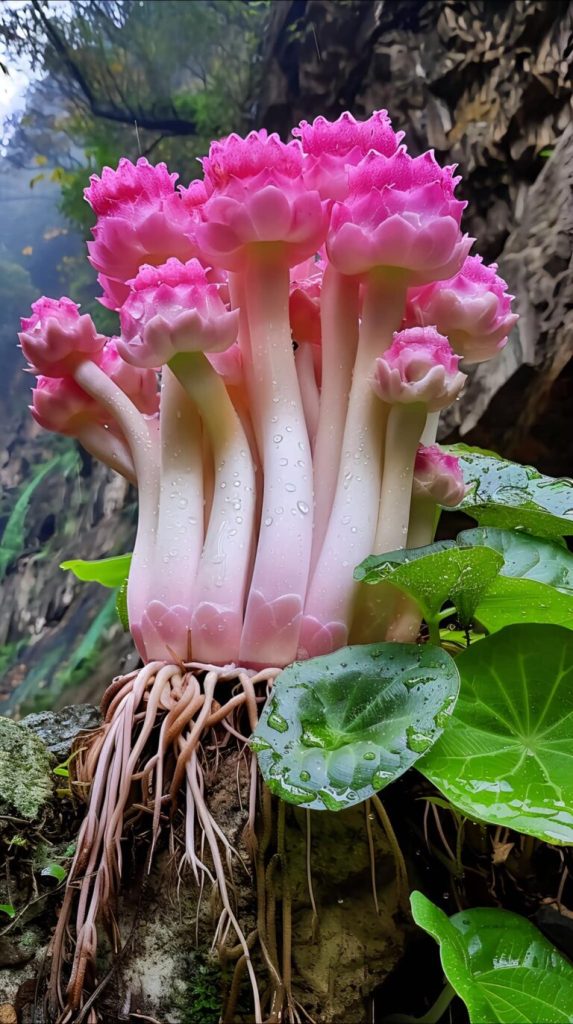
At its core, the Mystical Rock Lotus presents an inspiring story of survival. It thrives on minimal substrate conditions, often taking root literally on rocks, showcasing nature’s ingenuity in overcoming adversity. Within a temperature range of 60-75°F (16-24°C) and high humidity, this plant symbolizes not only environmental adaptation but also the broader theme of growth amidst challenge. The imagery of delicate white petals emerging from rugged stones evokes parallels to human experiences—where individuals find strength and beauty in their struggles.
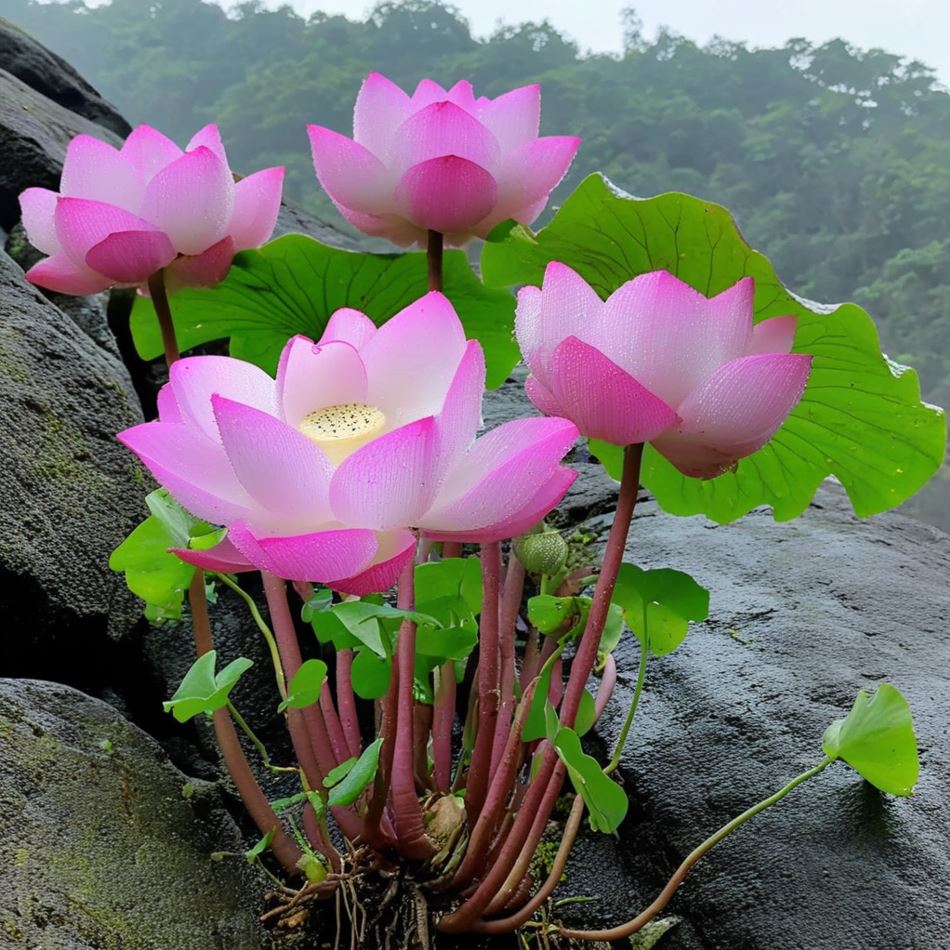
The Mystical Rock Lotus exemplifies nature’s resilience by flourishing in the most inhospitable conditions. These plants are known to take root directly on rocky surfaces, clinging to the bare minimum of soil and nutrients. This ability to thrive in seemingly barren environments is a testament to the ingenuity of the natural world.
Consider the imagery of a delicate flower blooming from the cracks of a rugged cliff face. This sight serves as a powerful metaphor for the human experience, where individuals overcome adversity and transform their challenges into sources of strength and beauty.
The Mystical Rock Lotus has evolved remarkable adaptations to survive in its harsh environments. Its hardy roots can penetrate deep into the crevices of rocks, extracting the necessary moisture and minerals to sustain its growth. The plant’s leaves and petals are designed to withstand intense sunlight and fluctuations in temperature, ensuring its continued flourishing.
This capacity for adaptation resonates with the human experience, where we are often faced with the need to adapt and find creative solutions to overcome obstacles. The rock lotus serves as a reminder that with the right mindset and resourcefulness, we too can thrive in the face of adversity.
The Mystical Rock Lotus’s ability to persevere in challenging conditions transcends the botanical realm. It represents a universal principle of resilience that can be applied to various aspects of human life, from personal growth to societal challenges.
By studying the rock lotus, we can draw inspiration and insights into how to cultivate our own resilience. Just as the plant defies the odds and flourishes against the odds, we can learn to embrace our own inner strength and emerge stronger from difficult circumstances.
Across diverse cultures, the rock lotus has evolved into a powerful symbol of spiritual enlightenment and personal growth. Its journey, from a tiny seed clinging to barren surfaces to a blooming wonder, resonates with many seeking transformation or healing. As the sacred lotus rises from muddy waters, cleansed and pristine, so too can individuals transcend their circumstances, reflecting profound truths about life and spirituality. This representation prompts introspection on how our own ‘roots’ can influence our evolution and contribution to the world.
The rock lotus has long been associated with themes of spiritual enlightenment and personal growth in various cultures. Its ability to thrive in harsh environments is seen as a metaphor for the human capacity to overcome inner challenges and achieve a state of purity and transcendence.
In many Eastern traditions, the lotus flower is revered as a symbol of the divine, representing the journey from the material to the spiritual realm. The rock lotus, with its unique ability to bloom in seemingly inhospitable conditions, is often viewed as a manifestation of this sacred journey.
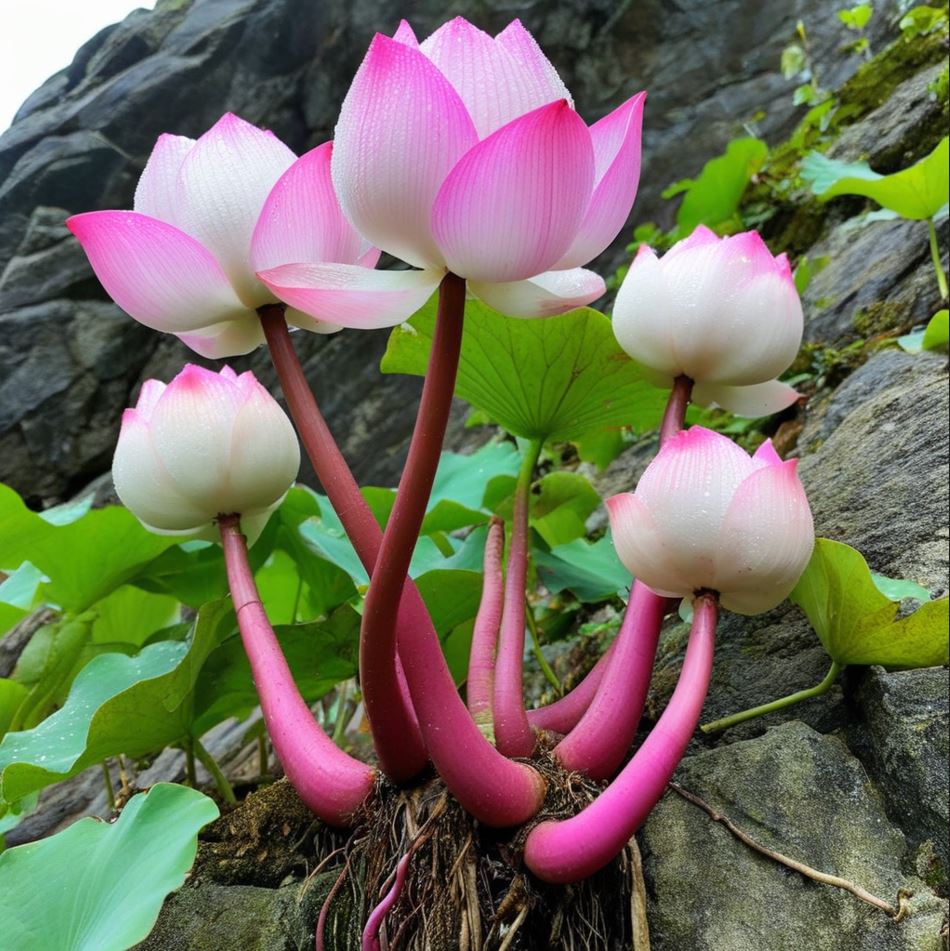
The rock lotus has found its way into the artistic and cultural expressions of diverse civilizations. In Vietnam, for instance, artisans have crafted intricate maps made entirely from succulent or rock lotus, blending nostalgia with creativity. These works emphasize not just the aesthetic appeal of the plant but also its capacity to evoke emotions and connect people through shared cultural symbols.
Imagine an art installation where the rock lotus serves as a bridge, linking past experiences to present realities—a metaphor for the intertwining of history and identity. Such representations allow us to explore the deeper significance of the rock lotus beyond its physical form.
The rock lotus’s symbolic association with transformation and healing resonates across various spiritual and wellness practices. Its journey from a seemingly lifeless seed to a blooming wonder is seen as a metaphor for the human ability to overcome personal challenges and emerge renewed.
In systems like Integrated Energy Therapy (IET), the rock lotus is employed as a symbol to help individuals release emotional blockages and promote balance in their lives. Just as the rock lotus emerges beautifully against all odds, these healing methodologies encourage people to confront their inner struggles and find their own paths to growth and wholeness.
The rock lotus’s cultural significance can also foster a sense of community and environmental stewardship. Collaborative projects that involve planting initiatives or local workshops centered on nurturing these beautiful flowers can bring people together while promoting the care and preservation of our natural surroundings.
Such collective efforts can lead to the creation of community gardens, serving as living testaments to resilience and the importance of caring for our shared ecosystems. By engaging with the rock lotus, individuals and communities can develop a deeper appreciation for the intricate interconnections within nature and their role as stewards of the environment.
Beyond its natural beauty, the rock lotus inspires a variety of artistic expressions. For instance, artists in Vietnam have crafted intricate maps made entirely from succulent or rock lotus, blending nostalgia with creativity. Such works emphasize not just the aesthetic appeal of the plant, but also its capacity to evoke emotions and connect people through shared cultural symbols.
The rock lotus has become a source of inspiration for artists who seek to integrate the natural world with their creative expressions. By incorporating the plant’s intricate forms, textures, and symbolic meanings into their works, artists are able to create pieces that resonate on multiple levels.
One can imagine an art installation where the rock lotus serves as a central motif, its delicate petals and rugged roots becoming the canvas for a narrative that explores the interplay between humanity and the natural environment. Such works can challenge the viewer to consider the deeper connections between the physical and the metaphysical.
The allure of the rock lotus has extended into the realm of commerce as well, with artificial versions available for purchase. While these replicas may lack the organic essence of their live counterparts, they offer a means for individuals to incorporate the beauty of the rock lotus into their homes, emphasizing how commodification can transform natural beauty into accessible art forms.
Moreover, platforms like Etsy showcase hand-crafted items inspired by this mythical flower, allowing creators to express their reverence for nature through unique craftsmanship. These products range from decorative sculptures to jewelry and household accessories, each one a testament to the enduring appeal of the rock lotus.
The rock lotus’s symbolic significance has also inspired collaborative artistic projects that bring together diverse communities. Imagine a community-based initiative where local artists, botanists, and gardeners work together to create a public installation featuring the rock lotus.
Such collaborative efforts not only celebrate the plant’s natural beauty but also serve as a platform for exploring its cultural and spiritual resonance. The resulting artwork could take the form of a living garden, a multimedia exhibition, or a series of performative interventions, all of which invite the public to engage with the rock lotus in meaningful and thought-provoking ways.
The commercialization of the rock lotus, through both artificial replicas and handcrafted products, raises intriguing questions about the boundaries between the natural and the artificial. While these manufactured versions may lack the organic essence of the living plant, they still possess a certain allure and allow for the broader dissemination of the rock lotus’s visual and symbolic appeal.
This interplay between the natural and the artificial can be explored further, challenging us to consider the ways in which technology and human ingenuity can both complement and potentially detract from our appreciation of the natural world. The rock lotus, as a symbol of resilience and transformation, can serve as a touchstone for navigating these complex dialogues.
Interestingly, the rock lotus is associated with holistic healing practices. A system known as Integrated Energy Therapy (IET) employs the symbolism of the violet energy ray, aiming to release emotional blockages and promote balance in one’s life. Just as the rock lotus emerges beautifully against all odds, these healing methodologies encourage individuals to confront their inner challenges and emerge stronger. This intersection of nature and wellness illustrates the potential for plants to serve as catalysts for transformative experiences in people’s lives.
The rock lotus is believed to possess unique energetic properties that align with holistic healing practices. In systems like Integrated Energy Therapy (IET), the plant’s symbolism is linked to the violet energy ray, which is associated with spiritual awakening, emotional release, and the cultivation of inner harmony.
By meditating on the rock lotus and its ability to thrive in harsh conditions, individuals can be encouraged to confront their own emotional and psychological obstacles. The imagery of the plant’s delicate blooms emerging from the cracks of a rocky surface can serve as a powerful metaphor for personal transformation and the unleashing of one’s true potential.
The rock lotus’s association with holistic healing extends beyond its symbolic significance. Some practitioners within the realms of aromatherapy, herbal medicine, and flower essences have explored the potential therapeutic benefits of the plant and its extracts.
For instance, rock lotus-infused essential oils or flower essences may be used in complementary therapies to promote relaxation, stress relief, and a heightened sense of inner balance. The plant’s resilience and ability to thrive in adverse conditions are seen as metaphors for the human capacity to overcome personal challenges and achieve a state of greater well-being.
The rock lotus’s spiritual and symbolic associations can also be leveraged in mindfulness and introspective practices. By contemplating the plant’s journey from a seemingly lifeless seed to a thriving, beautiful organism, individuals can be encouraged to reflect on their own personal growth and transformation.
Practices such as meditation, journaling, or guided visualization exercises involving the rock lotus can help cultivate a deeper sense of self-awareness, resilience, and connection to the natural world. This integration of the rock lotus into wellness practices highlights the plant’s capacity to serve as a catalyst for personal and spiritual exploration.
The rock lotus’s role in healing and wellness extends beyond individual experiences. Communities can rally around the plant as a symbol of unity and environmental stewardship. Collaborative projects that involve planting initiatives or local workshops centered on nurturing these beautiful flowers can foster connections among individuals while promoting the care and preservation of our natural surroundings.
Such collective efforts can lead to the creation of community gardens, serving as living testaments to resilience and the importance of caring for our shared ecosystems. By engaging with the rock lotus, individuals and communities can develop a deeper appreciation for the intricate interconnections within nature and their role as stewards of the environment.
In exploring the concept of the rock lotus, we unearth layers of meaning that go beyond mere biology. From its ability to thrive in harsh conditions to its representation of spiritual journeys and its role in art and wellness, the rock lotus stands as a testament to resilience, creativity, and interconnectedness within the human experience.
When exploring the world of orchids, one cannot overlook the allure and uniqueness of the Yellow Bird Orchid. This captivating flower, belonging to the genus Oncidium, is celebrated not only for its stunning appearance but also for the fascinating stories and symbolism entwined with its existence. The intricate beauty and vibrant color of this orchid evoke thoughts of sunshine and positivity, inviting deeper exploration into its characteristics, cultivation, and cultural significance.
The Yellow Bird Orchid is often recognized for its bright yellow blooms that resemble flying birds in flight, hence its name. Each flower exhibits a complex structure with long, slender petals that stretch out gracefully, creating an impression of movement. This resemblance to birds could symbolize freedom and joy, making it a favorite among gardeners and floral enthusiasts alike. The striking colors and shapes can serve as a reminder of the beauty found in nature, prompting us to appreciate even the smallest details in our surroundings.
The Yellow Bird Orchid’s unique structure is a testament to the remarkable diversity and adaptability of the orchid family. The flower’s key features include:
The intricate design of the Yellow Bird Orchid not only captivates the eye but also serves a practical purpose in the plant’s reproduction and survival. Understanding the underlying mechanisms that give rise to this unique appearance can deepen our appreciation for the remarkable evolution of orchids.
Beyond its physical attributes, the Yellow Bird Orchid holds profound symbolic significance in various cultures. The bird-like appearance of the blooms can be interpreted as representing freedom, joy, and the human desire to soar. Some cultures may associate the orchid with themes of transformation, as the graceful, airborne form of the flowers mirrors the metamorphosis that occurs in nature.
Furthermore, the vibrant yellow hue of the Yellow Bird Orchid is often linked to positivity, sunshine, and new beginnings. This color symbolism can evoke feelings of optimism, energy, and the embrace of life’s opportunities. Gifting a Yellow Bird Orchid may convey a message of encouragement, celebration, or the wish to uplift the recipient’s spirit.
Exploring the symbolic meaning of this orchid can inspire us to reflect on our own personal growth, the cycles of nature, and the ways in which we can cultivate more joy and positivity in our lives.
Growing and caring for Yellow Bird Orchids can be a rewarding and humbling experience. These plants require specific environmental conditions to thrive, mirroring the delicate balance we often seek in our own lives. The process of nurturing these orchids can serve as a metaphor for personal growth and resilience.
One of the key challenges in cultivating Yellow Bird Orchids is maintaining the proper balance of light, humidity, and air circulation. These orchids prefer warm, tropical environments with well-draining media and indirect sunlight. Achieving this balance can be a test of patience and adaptability, as growers may need to adjust their techniques based on the unique needs of their individual plants.
Tending to Yellow Bird Orchids also requires a vigilant eye for potential pests or diseases, and the willingness to address any issues that arise. This attentive care reflects the ongoing effort and dedication required to maintain healthy relationships, pursue personal goals, and navigate the ups and downs of life.
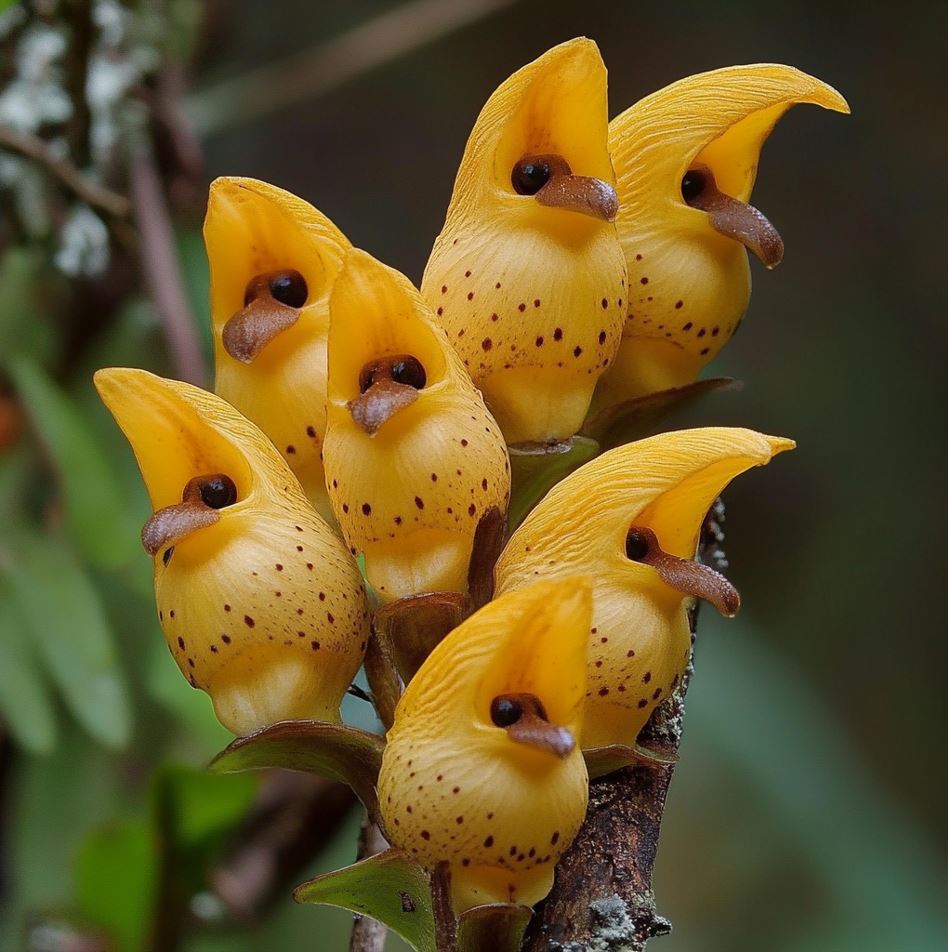
As gardeners learn from their experiences with Yellow Bird Orchids, they may begin to see parallels between the orchid’s journey and their own. The act of nurturing these delicate flowers can foster a deeper understanding of resilience, patience, and the value of embracing change – lessons that can be applied to various aspects of life.
Cultivating Yellow Bird Orchids requires patience and attention to detail, reflecting a broader metaphor of life’s journey. These orchids thrive in warm, humid environments, mimicking their native habitats in tropical regions. They require well-draining media and indirect light—conditions that mirror the balance we seek in our lives between nourishment and growth. When tending to these delicate flowers, one learns resilience, as the act of nurturing them through varying stages of development becomes akin to personal growth.
For Yellow Bird Orchids to flourish, gardeners must create an environment that closely replicates the orchid’s natural habitat. This involves carefully controlling factors such as temperature, humidity, and lighting.
Striking the right balance between these environmental factors requires patience, careful observation, and a willingness to adapt. As gardeners navigate the intricacies of Yellow Bird Orchid care, they may discover parallels to their own personal growth and the need to maintain equilibrium in various aspects of their lives.
Tending to Yellow Bird Orchids can be a labor of love, but the rewards it offers are truly remarkable. Witnessing the transformation of a small, dormant plant into a vibrant, flourishing specimen is a testament to the power of patience and dedication.
As growers invest time and effort into creating the perfect conditions for their Yellow Bird Orchids, they may experience a deep sense of pride and accomplishment. The act of nurturing these delicate flowers can foster a heightened appreciation for the natural world and the interconnectedness of all living things.
Furthermore, the beauty and elegance of the Yellow Bird Orchid’s blooms can have a profound impact on the gardener’s wellbeing. The sight of these graceful, bird-like flowers can evoke feelings of joy, tranquility, and a renewed connection to the rhythms of nature. This experience can serve as a reminder to slow down, appreciate the present moment, and find solace in the simple wonders that surround us.
By cultivating Yellow Bird Orchids, growers embark on a journey of personal growth, where they learn to navigate challenges, adapt to changing circumstances, and ultimately, reap the rewards of their hard work and patience.
In various cultures, orchids have been associated with beauty, luxury, and strength. The Yellow Bird Orchid, specifically, can symbolize thoughtfulness and friendship. Gifting such an orchid might convey a message of affection and appreciation towards the recipient, akin to sharing a piece of one’s heart through the gesture of gifting a living treasure. Moreover, the vibrant yellow of these flowers stands out in floral arrangements, often used in celebrations and gatherings symbolizing happiness and new beginnings.
The Yellow Bird Orchid’s vibrant hue and unique shape make it a popular choice for floral arrangements, where it can serve as a focal point or an accent piece. In many cultures, the inclusion of these orchids in bouquets and centerpieces can carry profound symbolic meaning.
The placement and use of Yellow Bird Orchids in floral arrangements can greatly influence the overall meaning and emotional impact of the display, underscoring the deep cultural significance associated with this remarkable flower.
Beyond its practical applications in floral design, the Yellow Bird Orchid holds profound symbolic significance in various cultural and spiritual traditions. The flower’s unique characteristics and visual resemblance to a bird in flight have inspired a range of interpretations and associations.
Exploring the rich symbolism surrounding the Yellow Bird Orchid can deepen our understanding of the flower’s cultural significance and its ability to inspire personal reflection and growth.
If one were to envision a landscape dotted with Yellow Bird Orchids, it conjures images of a lush, serene environment where colors come alive. This scene can evoke feelings of calm and tranquility, demonstrating how such flora enhances human experiences with nature. Furthermore, the growing popularity of cultivating these orchids at home reflects a larger trend of reconnecting with nature in our increasingly digital lives. It begs the question: what other lessons can we glean from engaging with nature?
Imagining a setting where Yellow Bird Orchids thrive can invoke a sense of peace and harmony. The vibrant yellow blooms against a backdrop of verdant foliage and rich, earthy tones can create a visually stunning and emotionally soothing environment.
By immersing ourselves in the captivating world of Yellow Bird Orchids, we can unlock the restorative power of nature and cultivate a greater appreciation for the delicate balance that exists within our ecosystems.
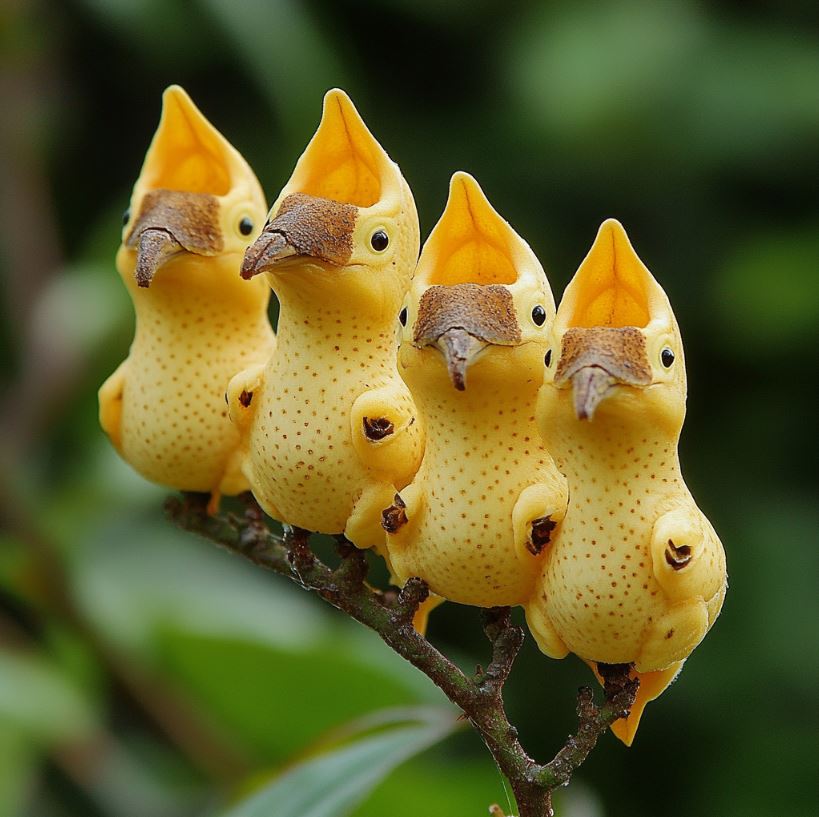
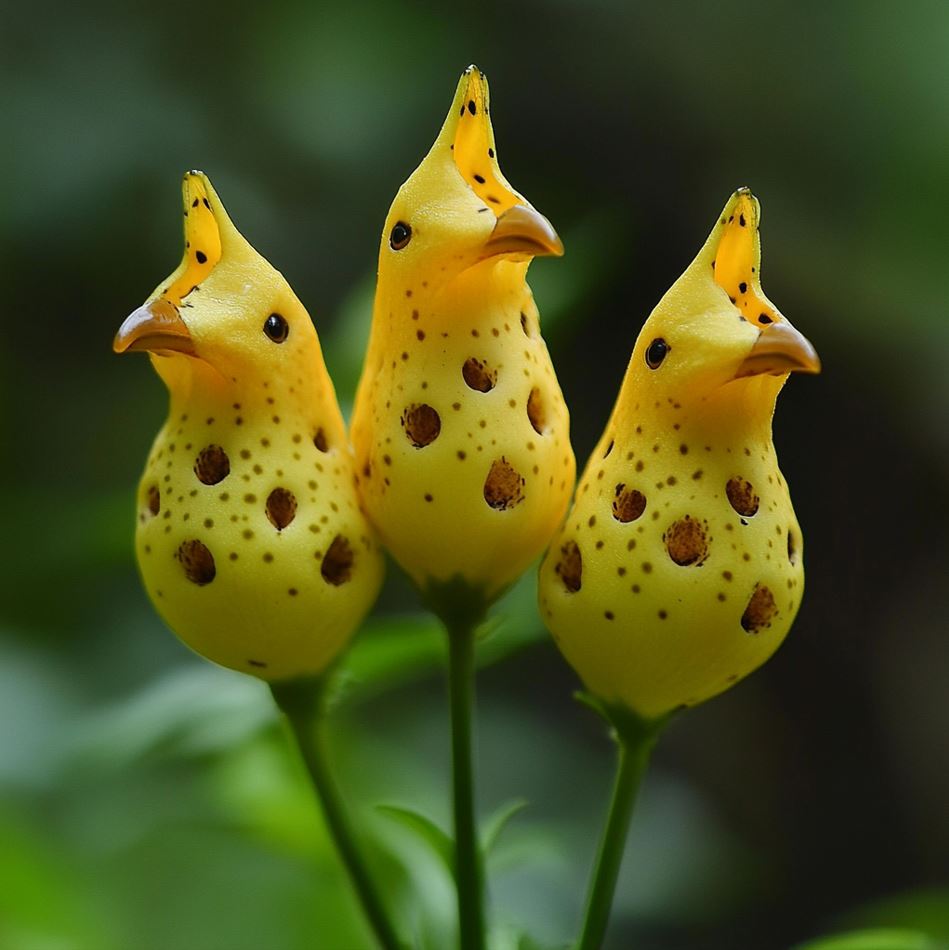
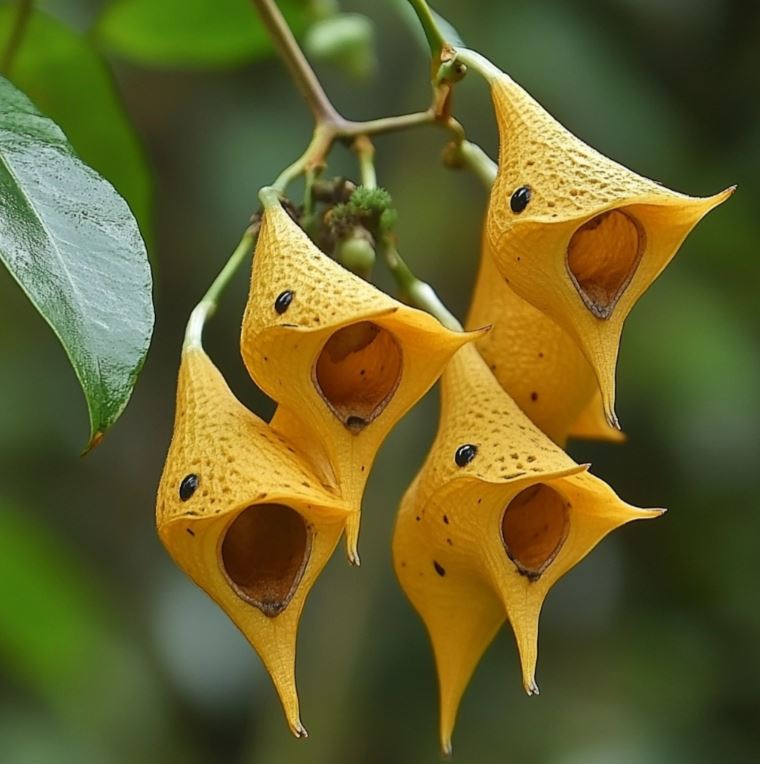
As the popularity of cultivating Yellow Bird Orchids at home continues to grow, it reflects a broader trend of individuals seeking to reconnect with nature in their daily lives. This pursuit can offer valuable insights into the concept of resilience, both in the context of plant care and personal growth.
By engaging with the cultivation of Yellow Bird Orchids, individuals can not only enjoy the beauty of these remarkable flowers but also glean valuable lessons about resilience, adaptability, and the profound interconnectedness between humanity and the natural world.
The Yellow Bird Orchid is not merely a visual delight; it represents a myriad of connections that weave together beauty, care, cultural significance, and personal growth. Through these lenses, one can appreciate the depth and richness this orchid brings to our lives and the profound insights it offers about nature and ourselves.
From the intricate structure of the flower to the symbolic meanings it carries in various cultures, the Yellow Bird Orchid invites us to slow down, observe, and connect with the subtleties of the natural world. Its cultivation, which requires patience, attentiveness, and the willingness to adapt, can serve as a metaphor for the personal journeys we undertake in our own lives.
Lily of the Valley, scientifically known as Convallaria majalis, is a captivating perennial herb that has long fascinated botanists, gardeners, and nature enthusiasts alike. With its delicate white bell-shaped flowers and intoxicating fragrance, this humble plant has woven itself into the fabric of human culture, symbolism, and personal experience. In this exploration, we’ll delve deep into the multifaceted world of Lily of the Valley, uncovering its botanical wonders, cultural significance, and the profound impact it has on our lives and environment.
Lily of the Valley, despite its unassuming appearance, harbors a wealth of botanical intrigue that has captivated scientists and nature lovers for centuries. This section will explore the plant’s unique characteristics, its ecological role, and the fascinating adaptations that have allowed it to thrive in diverse environments.
Lily of the Valley belongs to the asparagus family, a classification that might surprise many giventhe aesthetic differences between these plants. Its scientific name, Convallaria majalis, hints at its majesty as it is often associated with May Day celebrations in Europe where it blooms.
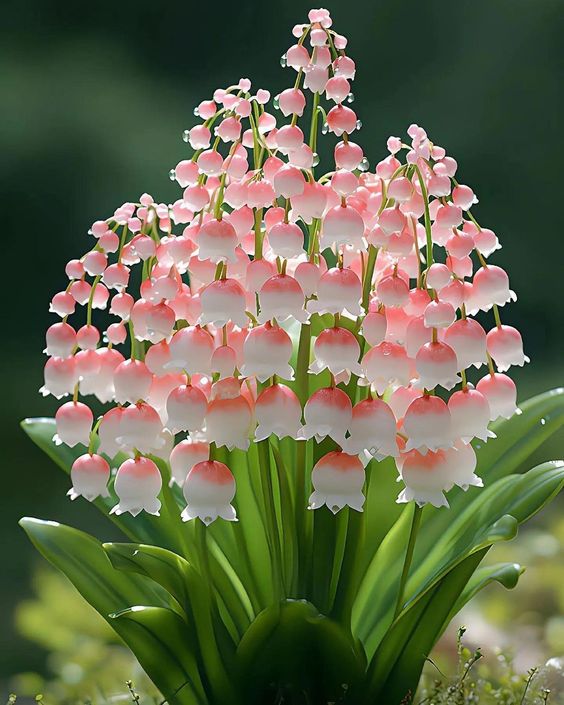
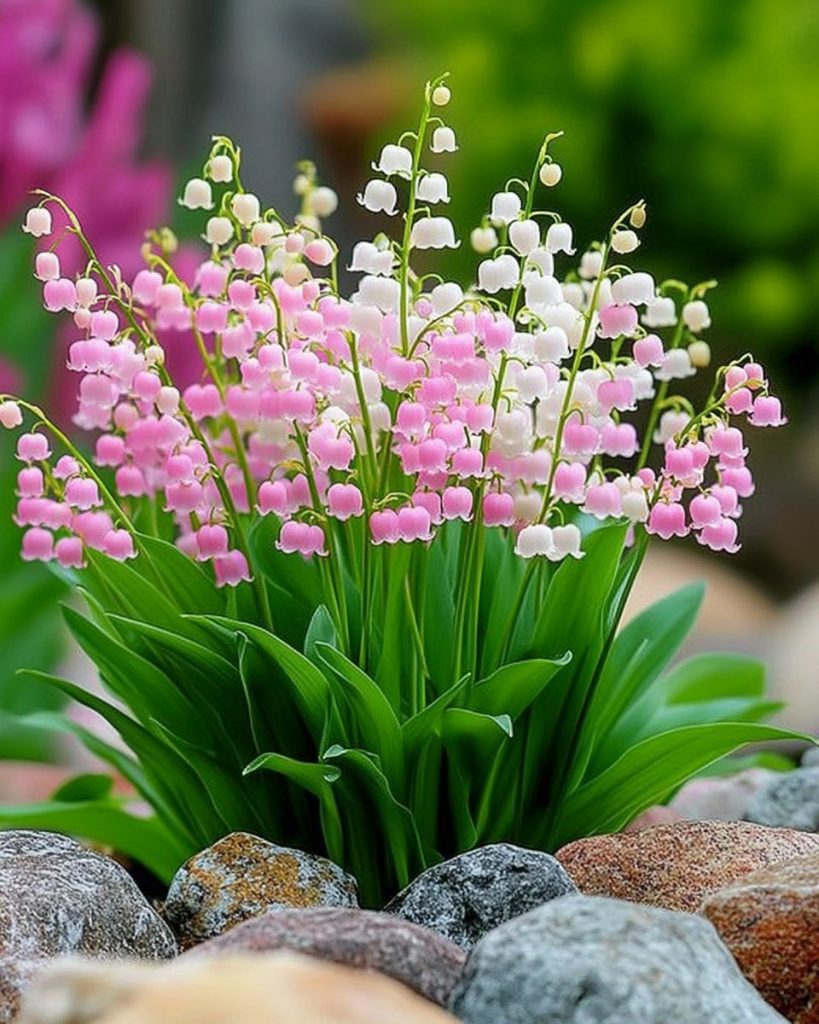
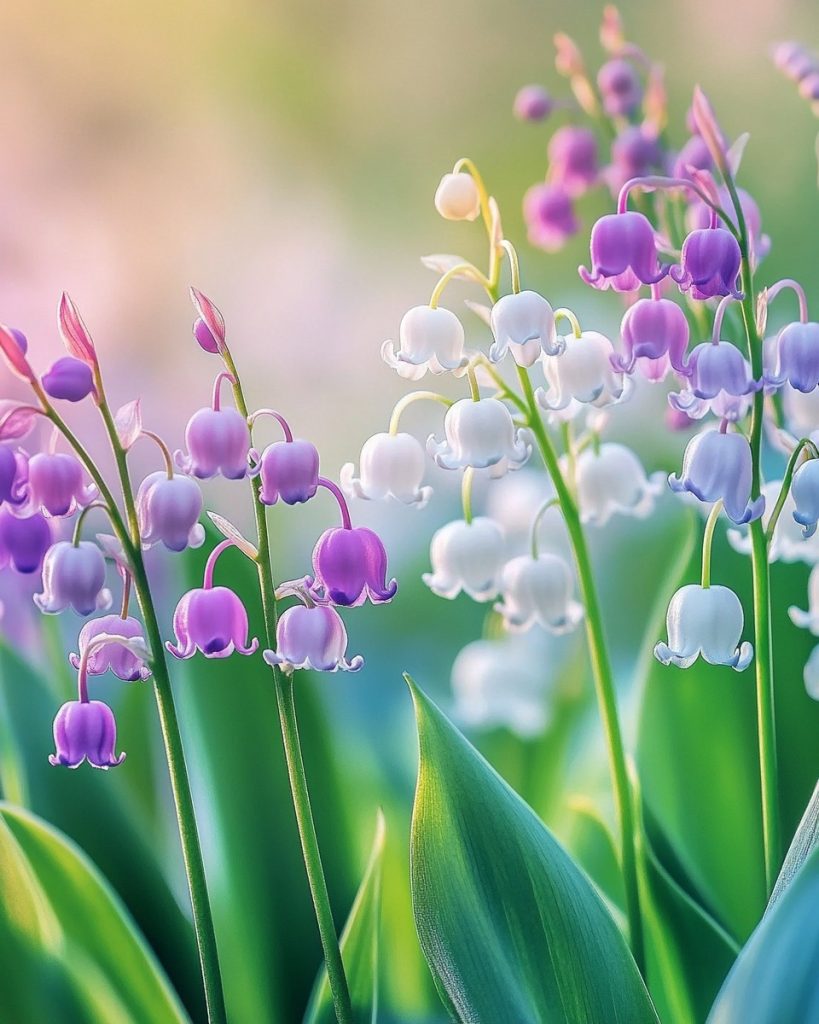
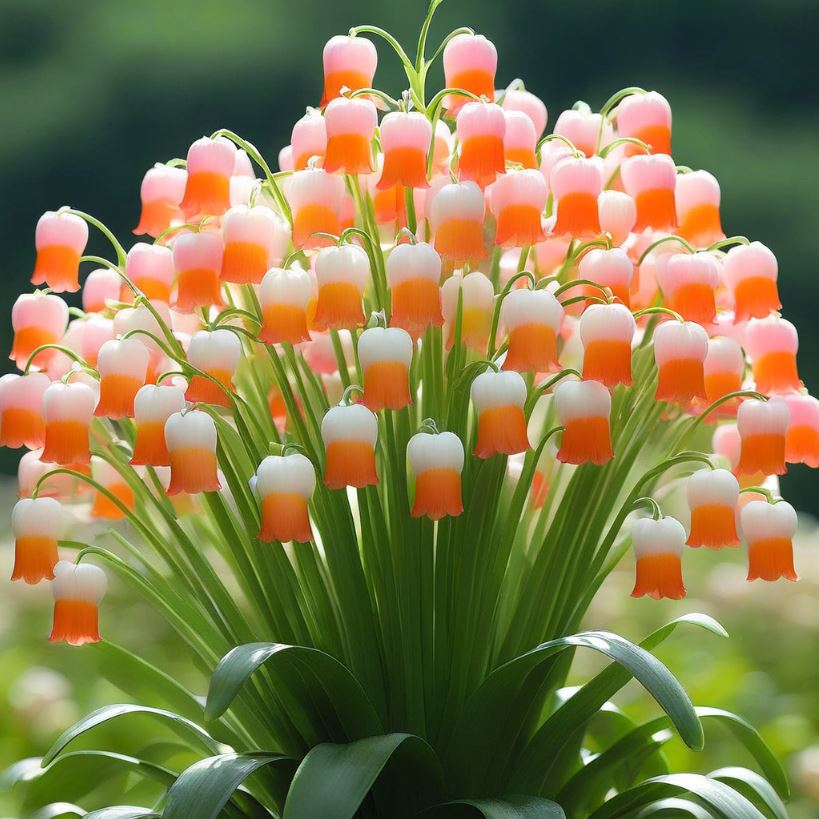
The plant features slender, arching leaves that grow from a rhizomatous root system, which allows it to spread and form dense colonies. Each stem produces small, pendulous flowers, typically white but occasionally tinged with pink, which bloom in graceful clusters. The beauty of these blossoms is complemented by their sweet, intoxicating fragrance that often lingers in the air, beckoning pollinators.
Ecologically speaking, Lily of the Valley plays an essential role in forest ecosystems. It thrives in shaded, moist environments, making it a vital component of the understory layer in deciduous woodlands. This not only provides ground cover that helps prevent soil erosion but also offers habitat for various creatures, including insects that rely on its nectar.
Lily of the Valley exhibits remarkable adaptations that enable it to flourish in diverse habitats. One of the most significant is its ability to thrive in low-light conditions, a characteristic that stems from its native woodland environment. The leaves are broad and rich in chlorophyll, allowing the plant to capture sunlight effectively even under the canopy of taller trees. This feature gives it a competitive edge over other plants in similar habitats.
Moreover, the plant’s rhizomatic growth is a clever adaptation that serves both reproductive and survival purposes. The rhizomes not only allow it to spread and colonize new areas, but they also store nutrients, enabling the plant to endure unfavorable weather conditions such as drought or excessive frost. This resilient nature showcases the plant’s evolutionary success and highlights its ability to adapt to fluctuating environmental factors.
Pollination plays a crucial role in the life cycle of Lily of the Valley, and understanding this aspect sheds light on its importance in the ecosystem. Although it is primarily self-pollinating, the delicate flowers attract various pollinators, including bees and butterflies, which assist in cross-pollination, producing genetically diverse offspring.
Interestingly, the timing of flowering aligns with the activity patterns of certain pollinators. In spring, when many other food sources are scarce, Lily of the Valley blooms abundantly, providing a vital resource for early-season pollinators. This symbiotic relationship underscores the intricate connections within ecosystems, as plants and animals depend on one another for survival and reproduction.
Lily of the Valley’s enchanting blooms extend far beyond botanical boundaries; they have found their way into folklore, traditions, and modern celebrations. The cultural significance of this delicate flower speaks volumes about human appreciation for nature and its wonders.
Throughout history, Lily of the Valley has been steeped in symbolism and tradition. Often associated with purity, humility, and sweetness, it has captivated hearts for generations. Ancient cultures revered the flower, believing it carried protective qualities, warding off evil spirits and bringing good fortune.
In medieval Europe, Lily of the Valley was linked to the Virgin Mary and symbolized her purity. Consequently, it became a popular motif in religious art and iconography. This deeply rooted association has perpetuated the flower’s reputation as a symbol of innocence and grace, inspiring poets and artists alike.
In modern times, Lily of the Valley continues to hold a cherished place in various celebrations. One notable event is the celebration of May Day, particularly in countries like France where the flower is traditionally gifted to loved ones as a token of good luck and happiness. The custom of giving these sweet-scented blooms carries a sense of joy and renewal, reminiscent of the arrival of spring.
Additionally, Lily of the Valley is a popular choice for weddings due to its associations with love and fidelity. Brides often choose the flower for their bouquets, incorporating its beauty and fragrance into their special day. The presence of this flower at such significant life events deepens its emotional resonance, offering both aesthetic allure and symbolic meaning.
As our understanding of environmental issues grows, so does the awareness of the need to conserve natural habitats where Lily of the Valley and other native plants thrive. While it can propagate easily in gardens and cultivated spaces, its natural populations are threatened by habitat loss, climate change, and invasive species.
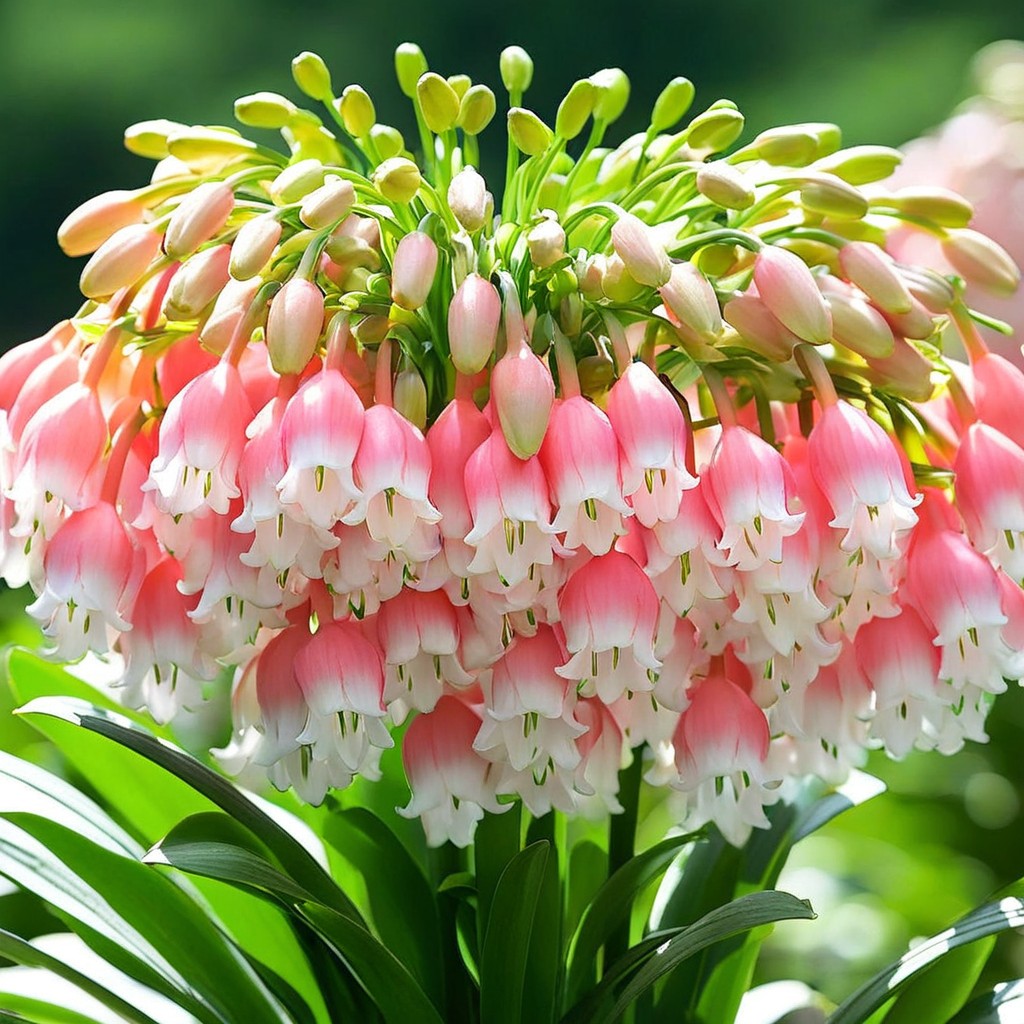
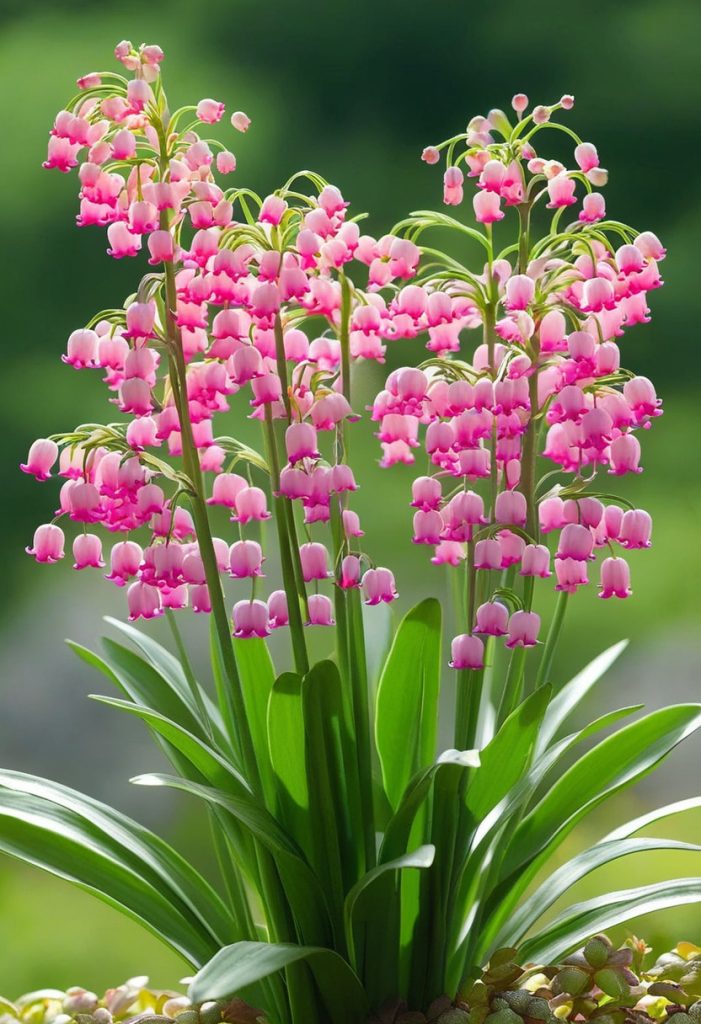
Various organizations and conservation groups work tirelessly to preserve the delicate ecosystems where Lily of the Valley flourishes. By raising awareness about the importance of preserving native flora, we can inspire future generations to appreciate and protect these enchanting plants and their habitats.
While Lily of the Valley delights the senses, it possesses medicinal properties that warrant careful consideration. This section explores the complexities of using this plant in herbal medicine, detailing its therapeutic potential while highlighting the risks associated with its toxicity.
Historically, Lily of the Valley has been used in traditional medicine for various ailments. It contains compounds such as glycosides that can be beneficial for heart health. These compounds have been shown to possess cardiac glycoside properties, which can help strengthen heart contractions and regulate heartbeat rhythm, making them valuable in treating conditions like heart failure.
Despite these therapeutic applications, it’s essential to approach the use of Lily of the Valley with caution. The same compounds that can benefit heart health may also lead to toxic effects if misused.
Lily of the Valley is not without its dangers. All parts of the plant contain toxic compounds that can lead to symptoms ranging from mild gastrointestinal upset to severe cardiac disturbances. Ingesting even small amounts can result in nausea, vomiting, and dizziness, while larger doses can cause more serious complications.
Due to its toxic nature, individuals should exercise extreme caution when considering the use of Lily of the Valley for medicinal purposes. Consulting with a healthcare professional familiar with herbal medicine is paramount before embarking on any treatment involving this enigmatic plant.
The conversation around the medicinal use of Lily of the Valley raises broader ethical considerations regarding wild harvesting and conservation. As demand for herbal remedies increases, the risk of overharvesting native plants looms large. Promoting sustainable practices ensures that we respect the ecological balance and protect the delicate ecosystems that support Lily of the Valley and countless other species.
The enchanting world of Lily of the Valley transcends its humble appearance, revealing a tapestry of botanical intrigue, cultural significance, and medicinal complexity. From its unique adaptations that allow it to thrive in challenging environments to its profound connections with human traditions and practices, this captivating plant offers endless avenues for exploration and appreciation.
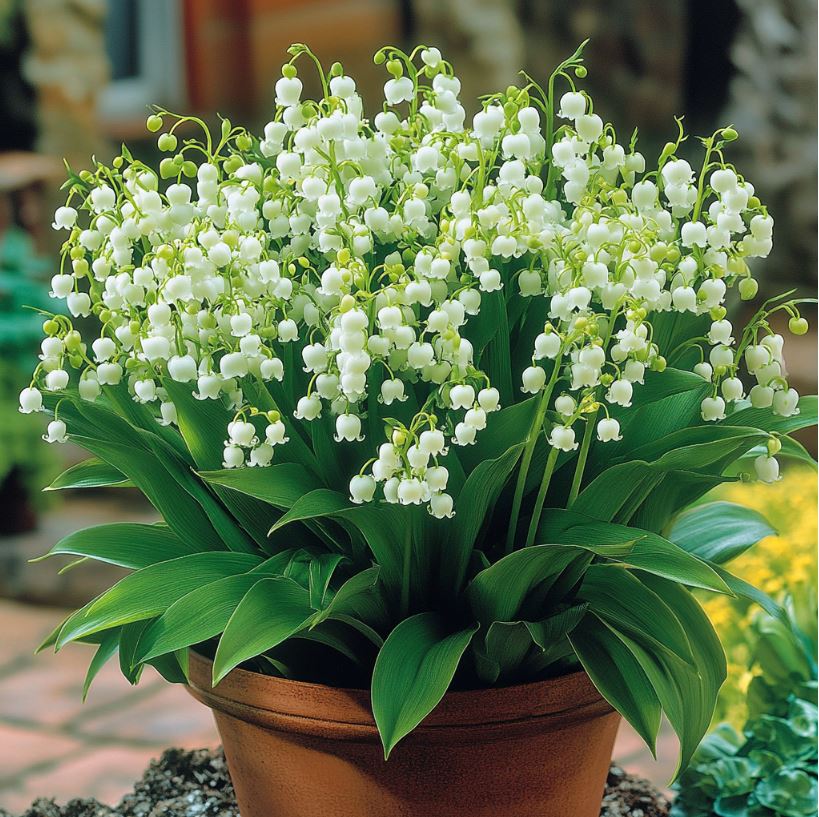

Cultivating the enchanting Pink Bell Lily (Lilium ‘Pink Bell’) can transform your garden into a vibrant tapestry of color and fragrance. These exquisite flowers are not just a feast for the eyes; they also symbolize admiration and femininity, making them a perfect addition to any landscape. Imagine walking through your garden surrounded by these delicate blooms, their soft pink hues gently swaying in the breeze—a true hallmark of spring.
Pink Bell Lily (Lilium ‘Pink Bell’) with white and pink bell-shaped flowers
A beautiful Pink Bell Lily (Lilium ‘Pink Bell’) featuring unique bell-shaped flowers with delicate white and pink petals.
Selecting the Right Environment
Climate Considerations
The first step in cultivating Pink Bell Lilies is understanding their preferred climate zones. According to resources like Easy to Grow Bulbs, selecting the right type of bulb for your specific climate zone is crucial. For instance, if you are in Zone 5, you might explore various spring-planted bulbs that complement this beautiful lily while ensuring proper growth conditions. Zone 6 offers even broader options, with a selection of bulbs ideal for those warmer temperatures.
When it comes to climate, Pink Bell Lilies thrive in temperate regions with four distinct seasons. They prefer cool, moist springs and moderate summers, with a gradual transition into autumn. In regions with harsh, prolonged winters, you may need to provide additional protection for the bulbs to ensure their survival. Carefully researching your local climate patterns and selecting the appropriate lily variety can make all the difference in cultivating a successful and vibrant display.
Soil Requirements
Lilies, including the Pink Bell, thrive in well-drained, fertile soil enriched with organic matter. You can augment your soil by incorporating compost or aged manure, ensuring it retains moisture without becoming soggy. This careful balance prevents bulb rot, allowing your Pink Bell Lilies to flourish beautifully.
Pink Bell Lily (Lilium ‘Pink Bell’) with dense clusters of pink and white bell-shaped flowers
A striking display of the Pink Bell Lily (Lilium ‘Pink Bell’) featuring densely packed clusters of bell-shaped flowers in a beautiful blend of pink and white hues.
When preparing the planting site, aim for a soil pH between 6.0 and 7.0, which provides the optimal nutrient balance for lilies. If your soil is too acidic, you can add lime to raise the pH; conversely, if it’s too alkaline, you can incorporate sulfur to lower the pH. Taking the time to amend your soil properly will create the perfect foundation for your Pink Bell Lilies to thrive.
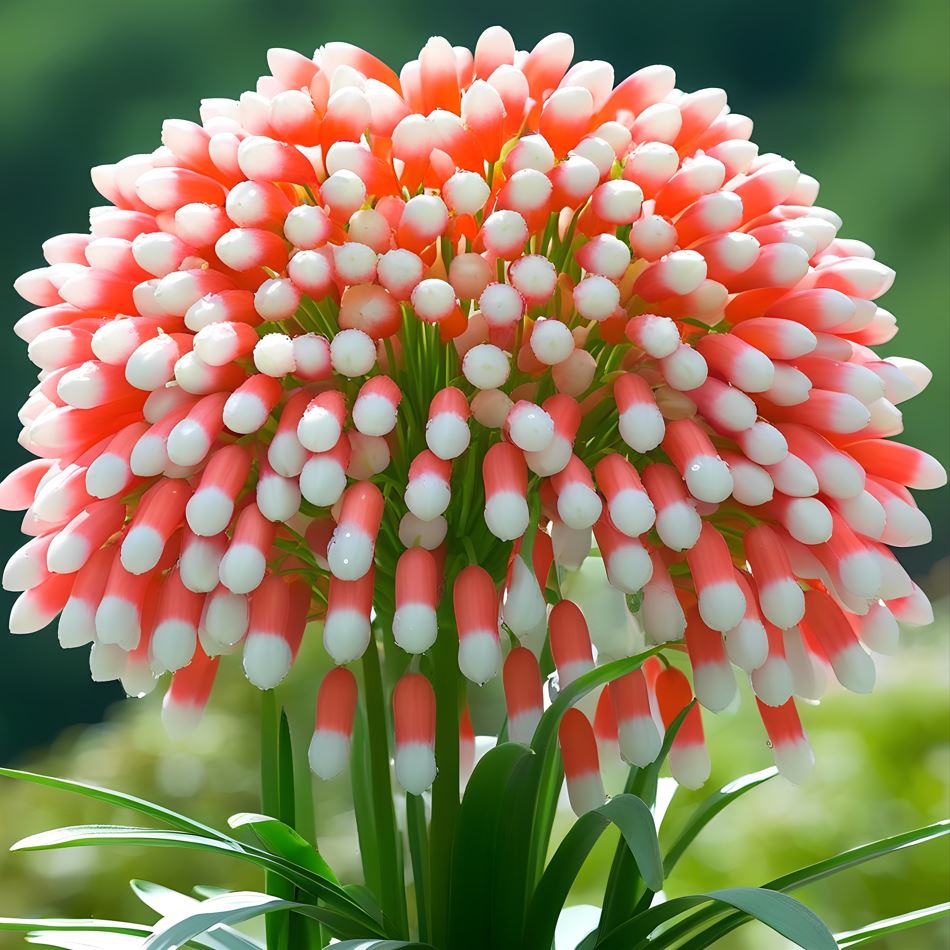
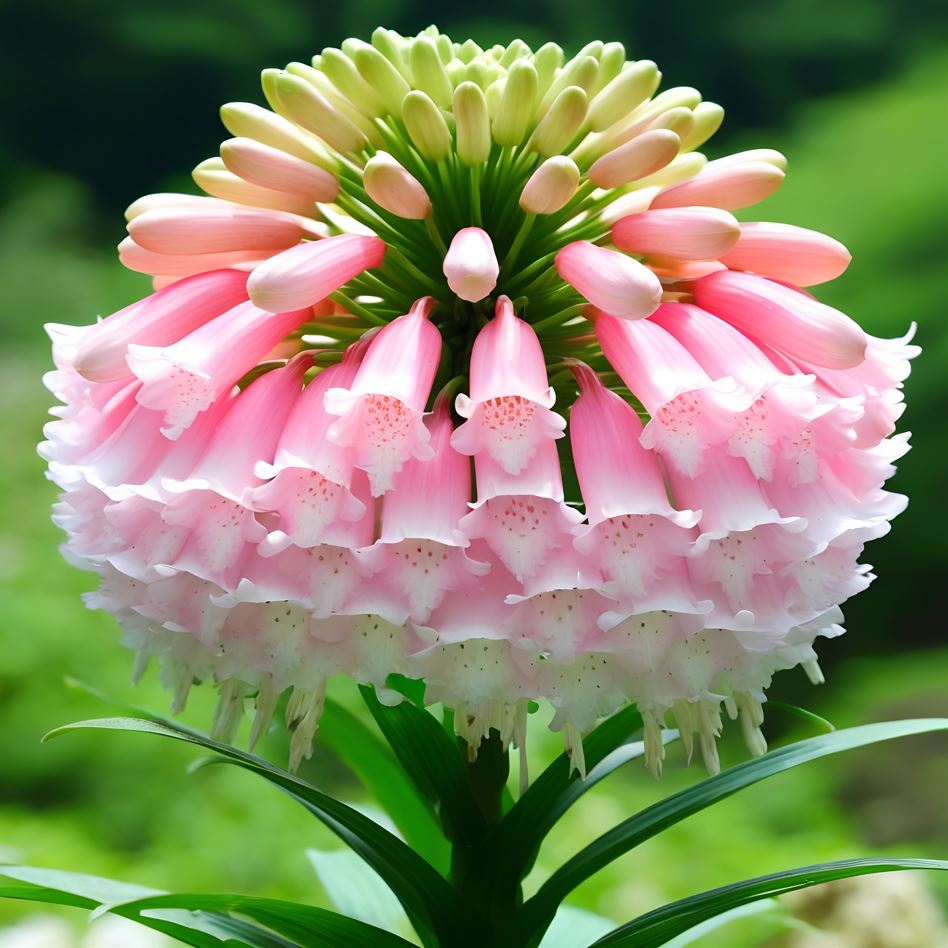
Planting Instructions
Timing & Spacing
To grow Pink Bell Lilies, timing is everything. Plant them in the spring when the soil has warmed up, ideally between March and May. The spacing should be about 12-18 inches apart to allow each plant room to grow and showcase their full beauty. Visualize a canvas where each flower acts as a brushstroke, contributing to the overall masterpiece of your garden.
When planting, ensure that the bulbs are placed at a depth of about 6-8 inches, with the pointed end facing upwards. This depth provides the necessary insulation for the bulbs, protecting them from temperature fluctuations and ensuring a robust root system. As the plants mature, they will develop a network of underground stems and roots, anchoring them firmly in the soil.
Watering Practices
Once planted, ensure that your Pink Bell Lilies receive consistent watering, particularly during dry spells. However, be cautious not to overwater, as this can lead to fungal issues. Think of watering as a nurturing embrace—gentle yet consistent, fostering growth without overwhelming the roots.
Pink Bell Lily (Lilium ‘Pink Bell’) with layered pink and white bell-shaped flowers
A captivating image of the Pink Bell Lily (Lilium ‘Pink Bell’) featuring layered clusters of bell-shaped flowers, blending soft pink and white colors.
During the growing season, aim to keep the soil moist but not saturated. Lilies have a high water demand, especially during the crucial flowering period. Providing a deep, thorough watering every week or two, depending on your local climate, can help maintain the optimal soil moisture levels. Avoid wetting the foliage when watering, as this can increase the risk of disease.
Enhancing Growth with Companion Plants
Color Harmony
Companion planting can elevate the aesthetic appeal of your garden significantly. Pair Pink Bell Lilies with other flowering plants, such as white daisies or purple salvias, which create a stunning contrast against their soft pink petals. This blend not only enhances visual interest but attracts beneficial pollinators, creating a lively ecosystem within your garden.
When considering companion plants, focus on species that share similar growing requirements, such as sunlight and soil preferences. This synergy ensures that all the plants in your garden thrive together, creating a harmonious and visually stunning display. Experiment with different color combinations and textures to find the perfect balance that complements your Pink Bell Lilies.
Nutrient Support
Consider incorporating other flowering species that share similar nutrient needs, thereby simplifying your care routine. For instance, planting alongside Petunias could encourage a synergy that optimizes nutrient uptake and enhances floral display. You can find more information about pink flowers and their companions from gardening resources like Epic Gardening, which provides a plethora of tips on flower combinations.
Vibrant Pink and White Bell-Shaped Flower Cluster
An eye-catching flower cluster featuring a dense arrangement of bell-shaped buds with a vibrant gradient of pink to white hues.
By strategically selecting companion plants, you can create a diverse and self-sustaining garden ecosystem that supports the growth and health of your Pink Bell Lilies. This approach not only enhances the visual appeal of your landscape but also helps to maintain a balanced and thriving environment.
Caring for Your Pink Bell Lilies
Pest Management
Monitoring for pests is essential in maintaining the health of your Pink Bell Lilies. Introduce natural predators like ladybugs to your garden, which will help control aphid populations. Likewise, using organic pest deterrents can safeguard your blooms without harming the environment.
Be vigilant for signs of pest infestations, such as chewed leaves or discolored foliage. Quickly addressing any issues can prevent the problem from escalating and protecting the overall health of your lilies. Additionally, maintaining good garden hygiene, such as removing fallen leaves and debris, can help discourage pests from taking up residence.
Seasonal Maintenance
As the seasons change, remember to cut back the foliage after blooming to conserve energy for next year’s blooms. It’s akin to letting your thoughts settle after a busy day—necessary for rejuvenation and growth.
In the autumn, once the foliage has died back, you can gently remove the dead material to prevent the accumulation of debris around the bulbs. This practice helps to reduce the risk of disease and ensure that the bulbs have the necessary resources to store energy for the upcoming growing season.
Conclusion
By integrating thoughtful planting techniques and considerations for your specific climate zone, you can cultivate a breathtaking display of Pink Bell Lilies that not only beautifies your space but also enlivens your spirit throughout the blooming season. From selecting the right environment to providing meticulous care, each step in the process contributes to the creation of a truly enchanting garden oasis. Embrace the beauty and fragrance of the Pink Bell Lily, and let it inspire you to cultivate a vibrant and thriving landscape that brings joy and serenity to your world.
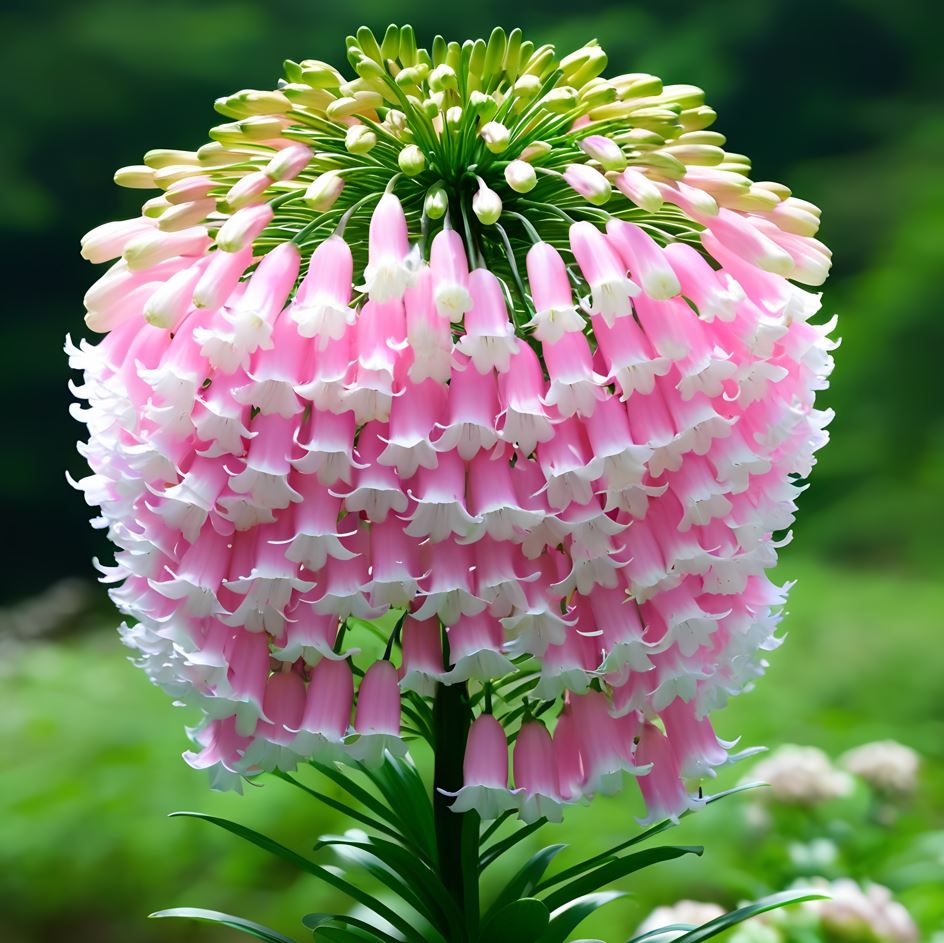
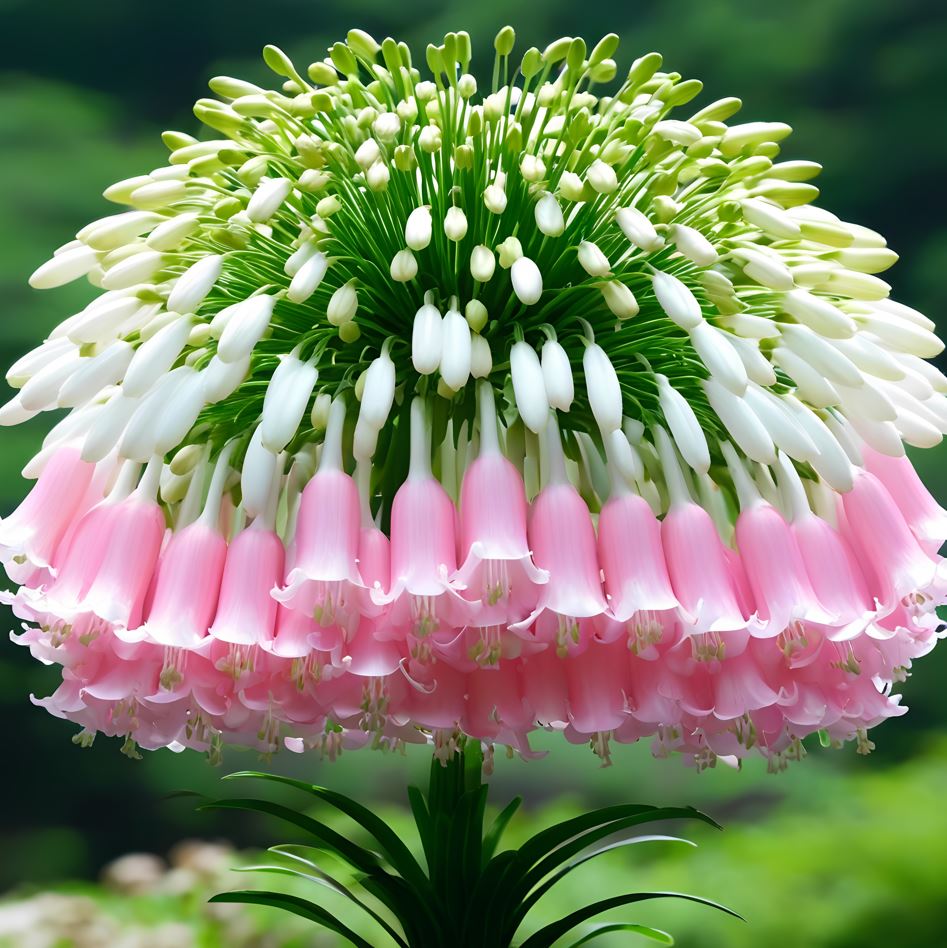
Growing hibiscus is both an art and a science. These stunning flowering plants are beloved by gardeners around the globe for their striking blooms and vibrant colors. While many people imagine hibiscus as a tropical plant, the truth is that there are varieties suited for virtually every climate. Whether you are in the temperate north or the sultry south, this guide will provide you with all the information necessary to cultivate and nurture your hibiscus plants successfully.
Hibiscus Candy Swirl, vibrant orange and yellow hibiscus flower in a garden
Hibiscus Candy Swirl – A stunning hibiscus flower with bright orange and yellow petals, adding a unique touch to any garden.
In this comprehensive article, we will delve into various aspects of hibiscus care, including essential requirements for light, soil, water, temperature, humidity, and fertilization. Different types of hibiscus will be explored, along with pruning techniques, propagation methods, potting practices, and how to deal with common pests and diseases. Additionally, we will discuss how to encourage blooming, address common problems, and provide post-bloom care for your hibiscus plants. With the right knowledge and care, your garden can be transformed into a tropical paradise bursting with the color and beauty of hibiscus.
Hibiscus Care
When it comes to hibiscus care, understanding the specific needs of the plant is crucial. Each species has its unique requirements, but there are several general guidelines that apply across the board.
The Importance of Regular Monitoring
Regularly checking on your hibiscus can help you catch any potential issues early on. This includes inspecting the leaves for signs of pests, checking the moisture content of the soil, and ensuring that the plant is receiving adequate light. A careful eye can make all the difference in maintaining healthy, thriving hibiscus plants.
White and red Hibiscus flowers in a potted plant, vibrant blooms with deep red centers
A beautiful potted Hibiscus showcasing striking white petals with deep red centers, perfect for indoor or outdoor decoration.
Seasonal Adjustments
Hibiscus requires different management depending on the season. In the summer, they may require more frequent watering and feeding, while in the winter, it’s crucial to reduce watering and halt fertilization for dormant varieties. Adjusting care based on seasonal changes can help you achieve healthier growth and more abundant blooms.
Tailoring Care to Species
Different hibiscus species also have varying care needs. For example, tropical hibiscus thrives in warm climates and may require indoor shelter during cooler months, while hardy hibiscus can tolerate colder temperatures. Understanding the specific variety in your garden will help you tailor your approach effectively.
Warning
While hibiscus plants are generally low-maintenance, it is essential to keep in mind certain warnings to prevent invasive behavior and maintain a healthy garden.
Potted Hibiscus with bright blue, red, and white flowers, vibrant multi-colored blooms
A vibrant potted Hibiscus featuring bright blue, red, and white blooms, perfect for adding a splash of color to any garden or patio.
Invasive Species Awareness
One of the major concerns with hibiscus is that some varieties can become invasive. Rose of Sharon (Hibiscus syriacus) is classified as an invasive species in several eastern states including Kentucky, Pennsylvania, Tennessee, and Virginia. It spreads easily and can take over gardens if not managed properly. Gardeners should practice deadheading flowers before seeds drop to curb unwanted spread.
Pests and Disease Risks
Despite being relatively resistant to most pests, hibiscus can still attract nuisances like aphids and spider mites, especially when conditions are dry. Consistent monitoring and preventive measures are essential. If problems arise, prompt action is required to ensure they do not escalate into larger infestations.
Potted Hibiscus with vibrant blue and red flowers, striking multi-colored blooms
A stunning potted Hibiscus featuring vibrant blue and red blooms, perfect for adding a lively touch to any outdoor space.
Soil and Water Management
Overwatering is one of the most common mistakes made by gardeners. Hibiscus prefers consistently moist soil, but too much water can lead to root rot and other issues. Make sure to monitor soil moisture and adjust your watering schedule as needed to avoid these pitfalls.
Light
Light plays a vital role in the growth and blooming of hibiscus plants. Understanding their lighting needs is essential for successful cultivation.
Full Sun vs. Filtered Sunlight
In northern regions, hibiscus thrives best in full sun, receiving at least six hours of direct sunlight per day. However, in southern areas where sunlight is more intense, filtered sunlight may be preferable to prevent leaf scorch.
Potted Hibiscus with large vibrant red flowers, stunning tropical blooms
A beautiful potted Hibiscus showcasing large vibrant red flowers, perfect for adding a tropical flair to your garden or home decor.
Indoor Lighting Conditions
For indoor hibiscus, finding a bright spot near a sunny window is key. Even so, strong, direct sunlight can be damaging. Consider using sheer curtains to diffuse light and protect your plant from scorching. When moving your hibiscus outdoors for the summer, gradually acclimate it to these brighter conditions to reduce shock.
Seasonal Changes in Light
As seasons change, so does the amount of available light. Be mindful of how varying daylight affects your hibiscus throughout the year. During shorter days in winter, consider using grow lights to supplement natural sunlight for indoor plants. This extra boost can help keep them healthy and thriving until spring returns.
Soil
Choosing the right soil is critical for supporting healthy hibiscus growth. The soil provides necessary nutrients and moisture retention for optimal plant health.
Woman next to giant Black Hibiscus flowers, unique dark blooms in a garden setting
A woman standing next to giant Black Hibiscus flowers, showcasing their unique dark petals and stunning size in a lush garden setting.
Characteristics of Ideal Soil
Hibiscus flourishes in well-drained, fertile, moist, loamy soil. The ideal pH level is slightly acidic to neutral, allowing optimal nutrient uptake. Such soil composition ensures that roots can breathe easily while retaining enough moisture without becoming waterlogged.
Amendments for Better Growth
To create the perfect environment, consider amending your native soil with organic matter such as compost or peat moss. This addition enhances drainage while increasing nutrient levels in the soil. Regular testing of soil pH can also provide insight into necessary amendments.
Container Gardening Tips
If you’re growing hibiscus in containers, choose pots that allow for good drainage. Make sure to use a high-quality potting mix formulated for flowering plants, providing the nutrients necessary for robust growth. Regularly check the soil moisture levels, especially in hot weather, to ensure your hibiscus gets the hydration it needs.
Oversized orange and cream Hibiscus flowers, stunning tropical blooms in sunlight
A close-up of oversized Hibiscus flowers with vibrant orange and cream petals, glowing beautifully under the sunlight in a tropical garden.
Water
Watering hibiscus correctly is crucial for maintaining health and promoting beautiful blooms. Understanding the plant’s water needs will enhance your gardening experience.
Consistently Moist Soil
Hibiscus thrives in consistently moist soil. It’s essential to keep the soil evenly damp but not soggy. Regular checks on moisture levels will guide your watering routine. Mulching around the base of the plant can help retain moisture and regulate soil temperature.
Watering Techniques
When watering, aim for deep saturation to encourage root development. It’s better to water thoroughly less frequently than to give small amounts of water often. For container-grown hibiscus, wait until the top inch of potting mix is dry before watering to prevent over-saturation.
Adapt to Weather Conditions
Adjust your watering frequency depending on the weather. In hotter months, especially in pots, you may need to water daily or every other day. Conversely, during periods of rain or cooler temperatures, reduce watering accordingly to protect against root rot.
Woman holding giant Black Hibiscus flowers, stunning dark blooms in a garden
A woman proudly holding giant Black Hibiscus flowers with deep, dark petals, creating a dramatic and exotic display in a lush garden setting.
Temperature and Humidity
Temperature and humidity significantly impact the health and vitality of your hibiscus plants. Understanding these factors helps create an optimal growing environment.
Temperature Preferences
Different hibiscus species have varied temperature tolerances. Hardy hibiscus can thrive in cooler climates, generally preferring temperatures between 60 to 90 degrees Fahrenheit. In contrast, tropical varieties are more sensitive to cold and should be sheltered indoors when temperatures drop below 50 degrees.
High Humidity Environments
All hibiscus plants flourish in humid environments. If you live in a dry climate, consider misting your plants or placing a humidity tray filled with water nearby. Indoors, bathrooms can serve as an excellent location due to naturally higher humidity levels.
Adapting to Climate Changes
Be prepared to modify care based on changing climate conditions. If your area experiences significant fluctuations in temperature or humidity, staying adaptable and responsive to your hibiscus’ needs will ensure continued success.
Hibiscus with pink and black petals, intricate spotted pattern creating a unique bloom
A close-up of a Hibiscus flower with striking pink and black petals, featuring an intricate spotted pattern that makes this bloom truly one-of-a-kind.
Fertilizer
Fertilizing your hibiscus plants correctly encourages healthy growth and vibrant blooms. Understanding what kind of fertilizer to use and when is crucial for optimal results.
Types of Fertilizers
Hibiscus benefits from fertilizers that are moderate in nitrogen, low in phosphorus, and high in potassium, such as 10-4-12 or 12-4-18 formulations. Although there are specialized hibiscus fertilizers available, any balanced flowering plant fertilizer can work as long as it meets these criteria.
Application Timing
During the growing season, regular feeding is essential. Use a diluted water-soluble fertilizer once a week for both hardy and tropical hibiscus. For hardy varieties, a granular slow-release fertilizer applied three times a year is beneficial: in early spring, after the first bloom cycle, and midsummer.
Post-Bloom Fertilization
After flowering, it’s important to reduce fertilizer application as the plant begins to enter dormancy. This pause allows the plant to rest and prepare for the next growing season without unnecessary stress from excess nutrients.
Multi-colored Hibiscus bouquet, vibrant pastel blooms with dewdrops
A stunning bouquet of multi-colored Hibiscus flowers, featuring soft pastel hues and delicate dewdrops, creating an eye-catching display in any garden.
Types of Hibiscus
The hibiscus genus encompasses a vast array of species, each offering unique characteristics. Familiarity with the most popular types will help you select the right fit for your garden.
Tropical Hibiscus
Tropical hibiscus (Hibiscus rosa-sinensis), also known as Chinese hibiscus, is renowned for its large, showy blooms. These plants produce vibrant flowers from spring through fall, provided they receive ample sunlight. Many varieties exist, including the popular ‘Fiesta,’ which features glossy dark green foliage and eye-catching orange blooms.
Hardy Hibiscus
Hardy hibiscus (Hibiscus moscheutos) is ideal for cooler climates. This North American native produces oversized flowers with delicate, ruffled petals in hues ranging from pink to lilac, red, and white. The ‘Perfect Storm’ cultivar is a compact hybrid that blooms later in the season, making it a beloved choice for many gardeners.
Swamp Hibiscus and Cotton Rose
Swamp hibiscus (Hibiscus coccineus) stands out for its large, pinwheel-like, bright red flowers that bloom during summer. Meanwhile, cotton rose (Hibiscus mutabilis) boasts flowers that transition in color from white or light pink to deep magenta within a few days. Both varieties showcase the incredible diversity within the hibiscus family.
Hibiscus flowers with purple and blue petals, shimmering with a starry pattern
A stunning group of Hibiscus flowers featuring deep purple and blue petals, adorned with a starry pattern that creates a mesmerizing, celestial effect.
Pruning
Pruning your hibiscus is essential for encouraging new growth, shaping the plant, and maintaining overall health.
Timing Your Pruning
Timing is critical when it comes to pruning hibiscus. Generally, pruning should occur in spring as soon as the weather warms up and before new growth begins. This early intervention stimulates fresh growth and flower buds for the upcoming blooming season.
What to Remove
For hardy hibiscus, cutting back any dead stems is crucial as they die back to the ground in winter. Removing any dead, damaged, or diseased stems should be done promptly to prevent potential disease spread. By doing this, you’ll set the stage for lush blooms come summer.
Black Hibiscus flowers with yellow speckles, striking and unique tropical blooms
A captivating group of Black Hibiscus flowers adorned with yellow speckles, creating a dramatic and unique display in any garden setting.
Tools for Effective Pruning
Investing in quality pruning tools is essential for maintaining your hibiscus. Sharp, clean pruners or shears minimize damage to the plant and promote quicker healing. Regular cleaning of tools will also prevent the transmission of diseases between plants.
Pruning Tip
To achieve the best results when pruning your hibiscus, engage in the following best practices:
Aim to Shape the Plant
Instead of simply cutting back, consider the shape of your hibiscus as you prune. This method encourages a bushier growth habit, resulting in more blooms. Regular shaping can also prevent overcrowding, which can affect air circulation and overall health.
Prune Only Healthy Stems
When removing stems, focus on those that are dead, damaged, or diseased. Healthy stems should remain intact, allowing the plant to flourish. This approach minimizes stress on the plant and promotes vigorous growth.
Keep Track of Growth Patterns
Observing growth patterns over time will help you understand the best pruning methods for your particular hibiscus variety. Each plant may respond differently, allowing for tailored care and maintenance.
Hibiscus (Apricot Glow)
Hibiscus (Apricot Glow)
Propagating Hibiscus
Propagation is an exciting way to expand your hibiscus collection and share these beautiful plants with friends and family. Understanding the different methods for propagation is essential for success.
Stem Cuttings vs. Seeds
Some hibiscus types are best propagated from stem cuttings, while others can be grown from seed. For instance, swamp hibiscus and roselle (Hibiscus sabdariffa) are excellent candidates for seed propagation. However, many hybrids and cultivars do not produce true-to-parent plants from seed, making stem cuttings the preferred method for most gardeners.
Step-by-Step Instructions
For stem cuttings, select healthy shoots with at least two nodes. Cut just below a node and remove the lower leaves. Place the cutting in a pot filled with moist potting mix and cover it with plastic to maintain humidity. After a few weeks, roots should begin to form. Once established, they can be transplanted into individual pots or directly into the garden.
Best Time to Propagate
The optimal time for propagating hibiscus is during the growing season in spring or early summer. Warm temperatures and longer daylight hours facilitate faster rooting and establishment for your new plants.
How to Grow Hibiscus From Seed
Growing hibiscus from seed can be a rewarding process, although it requires patience and diligence. Here are steps to successfully germinate hibiscus seeds.
Hibiscus ‘Pink Dream’
Hibiscus ‘Pink Dream’
Choosing Quality Seeds
Select high-quality seeds specifically bred for your chosen hibiscus variety. Fresh seeds tend to germinate better, so sourcing from reputable suppliers is crucial.
Preparing for Germination
Before planting, soak the seeds in water for 24 hours to soften the hard outer shell. This soaking process increases the chances of successful germination.
Planting Seeds
Sow the seeds in a tray filled with seed starting mix, covering them lightly with soil. Maintain consistent moisture, ensuring not to overwater. Ideally, place the tray in a warm, sunny location or under grow lights to promote germination.
Potting and Repotting Hibiscus
Potting and repotting hibiscus are vital practices to ensure healthy growth, especially for container-grown varieties.
Signs It’s Time to Repot
Your hibiscus may need repotting if you see roots emerging from drainage holes or if water is not soaking into the soil efficiently. Over time, hibiscus can outgrow their pots, leading to stunted growth if not addressed.
Hibiscus ‘Red Tiger’
Hibiscus ‘Red Tiger’
Choosing the Right Pot
Opt for wide but shallow pots to promote blooming rather than excessive root growth. When selecting a new pot, ensure it is only one size larger than the current pot to avoid overwhelming the plant.
Repotting Process
To repot, carefully remove the hibiscus from its existing pot, shaking off excess soil. Inspect the roots for any signs of rot and trim as needed. Place the hibiscus in its new pot, fill with fresh potting mix, and water thoroughly to help establish the plant in its new environment.
Overwintering
Overwintering your hibiscus, particularly tropical varieties, is essential for ensuring their survival during colder months.
Indoor Transition
As temperatures drop and nighttime frosts approach, bring your tropical hibiscus indoors. Before relocating, cut the plant back by one-third and thoroughly spray it with water to eliminate any pests or debris.
Creating a Suitable Environment
Once indoors, place the hibiscus in a warm location with plenty of indirect sunlight. Avoid exposing the plant to drafts or extreme temperature fluctuations. Additionally, reduce watering, allowing the soil to almost dry out between sessions.
Managing Leaf Drop
It’s normal for tropical hibiscus to drop leaves during dormancy. This process helps conserve energy. Don’t panic; consistent care will support regrowth come spring.
Common Pests & Plant Diseases
While hibiscus plants are generally resilient, they can fall victim to certain pests and diseases. Knowing what to look for and how to manage these issues will help keep your plants healthy.
red and blue, white flower hibiscus
red and blue, white flower hibiscus
Identifying Common Pests
Aphids and red spider mites are common pests that can be particularly troublesome for hibiscus. Aphids result in sticky residue on plants, while spider mites often leave webbing and speckled leaves.
Preventive Measures
To deter pests, regularly clean your plants by wiping down leaves and applying insecticidal soaps if necessary. Maintain high humidity levels to discourage spider mites and monitor for aphids, which are attracted to tender new growth.
Addressing Plant Diseases
Root rot is one of the primary diseases affecting hibiscus, usually resulting from overwatering or poor drainage. If you observe wilting leaves and mushy roots, take immediate action by adjusting your watering routine and repotting if necessary.
How to Get Hibiscus to Bloom
Encouraging your hibiscus to bloom requires attention to care details and environmental factors.
Blooming Seasons
Hibiscus typically blooms from June to early fall, although tropical varieties may continue into winter months in warmer climates. Understanding the bloom cycle helps you plan for care accordingly.
Factors Influencing Blooms
Several elements influence blooming. Insufficient light, lack of fertilization, and improper watering can all hinder flower production. Ensuring your hibiscus receives adequate sunlight, nutrients, and moisture will promote a bountiful display.
Encouraging More Blooms
To stimulate blooming, consider weekly feeding with diluted liquid fertilizer. This nourishment supports healthy foliage and abundant flower production. Regularly deadheading spent blooms can also encourage further flowering by redirecting energy to new buds.
Bloom Months
Depending on the species, hibiscus blooms can vary widely in timing.
Seasonal Variations
Hardy hibiscus typically showcases flowers from mid- to late summer until the frost arrives. On the other hand, tropical hibiscus tends to bloom from spring through late fall, and even into winter in frost-free areas, making them excellent choices for prolonged color.
Individual Flower Lifespan
Most hibiscus flowers are short-lived, lasting only about a day before closing and eventually falling off. However, the trade-off is an extensive blooming period, ensuring a continuous display of beauty throughout the growing season.
How Long Does Hibiscus Bloom?
Understanding the blooming duration of hibiscus can help you plan for seasonal enjoyment.
Daily Flower Lifespan
Individual flowers of hibiscus last for a brief period—typically one day. This fleeting beauty emphasizes the importance of regular inspection and care to maximize blooming potential.
Overall Blooming Period
Despite their short lifespan, hibiscus offers a long blooming period, providing countless opportunities to appreciate their exquisite beauty. With proper care, your hibiscus can deliver colorful displays throughout the growing season.
What Do Hibiscus Flowers Look and Smell Like?
Hibiscus flowers are a feast for the eyes, but they are generally devoid of scent.
Size and Color Spectrum
Flowers vary in size from two to twelve inches, showcasing a kaleidoscope of colors from white, pink, red, yellow, orange, purple, and blue. Each bloom presents a trumpet-shaped design, often featuring single or double petals.
Hibiscus ‘Silver Edge’
Hibiscus ‘Silver Edge’
Absence of Fragrance
Interestingly, hibiscus flowers do not emit fragrance, which can sometimes surprise gardeners. Their allure lies primarily in visual appeal rather than olfactory delights, attracting pollinators like butterflies and hummingbirds instead.
How to Encourage More Blooms
To increase blooming in your hibiscus plants, several strategies can be employed.
Assessing Light Levels
First and foremost, ensure your hibiscus is receiving sufficient light. Insufficient sunlight often leads to reduced blooming, so evaluate the plant’s position and adjust as necessary.
Fertilization Regimen
Feeding your hibiscus with a balanced fertilizer can also spur blooming. Applying liquid fertilizer every week during the growing season delivers vital nutrients, enhancing flower production.
Practicing Deadheading
Regularly deadheading spent flowers redirects energy to new bud formation. This practice keeps your hibiscus looking tidy and encourages continual blooming, creating a more vibrant landscape.
Caring for Hibiscus After It Blooms
Post-bloom care is essential to maintain the health and vigor of your hibiscus plants.
Nutrient Adjustment
After the blooming period, it is wise to reduce feeding to allow the plant to rest. This period of dormancy is crucial for preparation for the next growth cycle.
Monitoring for Pests
Continue to monitor your hibiscus for pests and diseases even after blooming ceases. Regular inspections can prevent infestations and ensure the plant remains healthy throughout the year.
Preparing for Dormancy
As the growing season ends, begin adjusting care routines to prepare your hibiscus for dormancy. Gradually reduce watering and adjust indoor light exposure to simulate natural seasonal changes.
Deadheading Hibiscus Flowers
Deadheading is a simple yet effective technique for enhancing the performance of your hibiscus plants.
When to Deadhead
Identify spent flowers for removal as soon as they wilt. Removing these blooms encourages the plant to direct resources towards producing new growth and flowers.
Techniques for Effective Deadheading
Using sharp, clean pruning shears, cut the spent bloom just above the next set of leaves, promoting bushier growth. Engaging in this process regularly helps maintain the overall appearance of the plant while boosting blooming potential.
Common Problems With Hibiscus
Being aware of potential issues can save gardeners time, effort, and disappointment.
Yellow Foliage
Yellowing leaves can signal various issues, including overwatering, lack of nutrients, or inadequate light. Assess your watering habits and nutritional regimen to identify the cause and implement corrective actions.
Dropping of Buds
Bud drop can occur due to stress factors like sudden temperature changes, fluctuating moisture levels, or pest infestations. Addressing these factors quickly can help ensure your hibiscus remains healthy and productive.
Conclusion
In summary, growing and caring for hibiscus is a fulfilling endeavor that rewards diligent gardeners with magnificent blooms and vibrant colors. By understanding the unique needs of hibiscus plants, including light, soil, water, and temperature, you can create an inviting environment for these tropical beauties. Armed with knowledge about common challenges, pest control, and effective pruning techniques, you will be well-equipped for nurturing healthy hibiscus throughout the seasons.
Tropical orchids are some of the most captivating and awe-inspiring plants in the world. With their vibrant colors, intricate patterns, and delicate blooms, these exotic beauties have the power to transform any space into a serene oasis. Whether you’re a seasoned gardener or a novice plant enthusiast, mastering the art of growing tropical orchids can be a truly rewarding experience.
Exotic Tropical Orchid with human-like shape and speckled purple and cream petals
An extraordinary Exotic Tropical Orchid displaying a unique human-like shape with speckled purple and cream petals, highlighting nature’s artistry.
In this comprehensive guide, we’ll delve into the intricacies of cultivating these stunning flowers, exploring the essential environmental conditions, care techniques, and personal insights that can help you unlock the secrets to their successful growth.
Understanding Your Orchid’s Needs
The foundation of a thriving tropical orchid lies in understanding its specific requirements. From the ideal soil composition to the optimal temperature and humidity levels, every aspect of the plant’s environment plays a crucial role in its well-being.
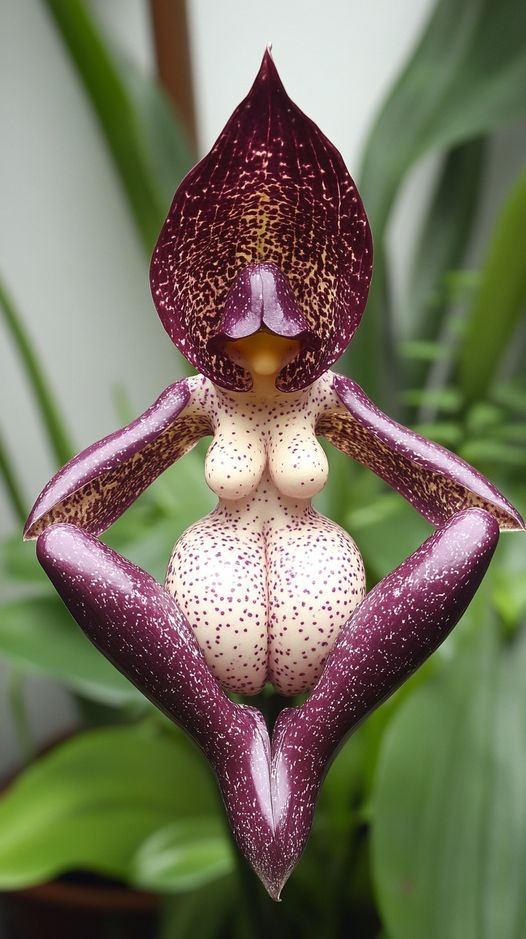
Soil Composition
The right soil mix is the cornerstone of a healthy orchid. Unlike many other houseplants, tropical orchids thrive in well-draining, nutrient-rich potting mixes. These mixes typically include a combination of bark, perlite, and sphagnum moss, which provide the perfect balance of aeration and moisture retention. Ensuring the right soil composition is essential, as orchid roots can easily rot in waterlogged conditions.
Exotic Tropical Orchid with human-like legs and speckled purple petals
A remarkable image of an Exotic Tropical Orchid featuring a unique form with human-like legs and speckled purple petals, showcasing nature’s creativity.
When selecting a potting mix, it’s important to choose one that is specifically formulated for tropical orchids. These specialized mixes are designed to mimic the natural growing conditions of these plants, providing the ideal substrate for their delicate root systems to flourish. Regularly repotting your orchids in fresh mix can also help maintain their vigor and prevent issues such as compaction or nutrient depletion.
Temperature and Humidity
Temperature and humidity are two critical factors in the successful cultivation of tropical orchids. These plants generally thrive within a temperature range of 65-85°F (18-29°C), with a preference for the warmer end of the spectrum during the growing season.
Maintaining the correct humidity levels is equally important. Tropical orchids require moderate to high humidity, typically between 40% to 70%. In a home environment, this can be a challenge, as many indoor spaces tend to be on the drier side. To overcome this, consider placing your orchids near a humidifier or using pebble trays filled with water to increase the moisture levels in the air around them.
Paying close attention to temperature and humidity fluctuations is essential, as sudden changes can stress the plants and inhibit their growth or even lead to premature flower drop. By creating a stable, orchid-friendly environment, you can ensure your tropical beauties reach their full potential.
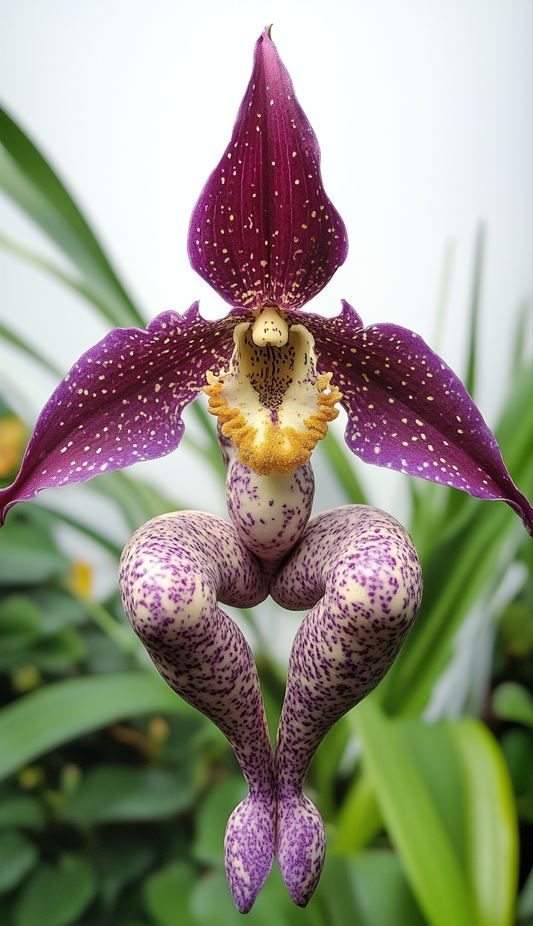

Essential Care Tips
Proper care is the key to unlocking the true beauty and longevity of your tropical orchids. From watering regimens to nutrient supplementation, every aspect of their maintenance requires careful consideration.
Watering Regimen
Watering is a critical aspect of orchid care, and getting the balance right can be a delicate dance. Tropical orchids require consistent moisture, but they are equally susceptible to the dangers of overwatering. The goal is to keep the potting mix evenly moist, allowing the top inch of the soil to dry out before rewatering.
Exotic Tropical Orchid with unique human-like form and speckled purple and yellow petals
An incredible Exotic Tropical Orchid with a distinctive human-like form, featuring speckled purple and yellow petals that showcase the captivating creativity of nature.
To achieve this, it’s essential to check your orchids regularly and water them accordingly. Avoid letting the mix become completely dry, as this can cause stress and inhibit growth. Conversely, be vigilant about not letting the roots sit in standing water, as this can quickly lead to root rot and other fungal issues.
One helpful tip is to water your orchids in the morning, allowing any excess moisture to evaporate during the day. This helps prevent the risk of stagnant water and reduces the likelihood of disease development.
Nutrient Supply
Fertilizing your tropical orchids correctly can make a world of difference in their growth and blooming potential. These plants require a balanced diet of essential nutrients to thrive, and a well-timed feeding schedule can provide the necessary support.
During the active growing season, use a water-soluble, balanced fertilizer every 2-3 weeks. The ideal ratio for orchids is typically something like 20-20-20 or 30-10-10, providing a mix of nitrogen, phosphorus, and potassium. This feeding regimen will help fuel the plant’s development, promoting robust foliage, strong root systems, and abundant blooms.
Exotic Tropical Orchid with a unique form and intricate purple and yellow petals
A stunning Exotic Tropical Orchid showcasing an extraordinary form with detailed purple and yellow petals, reflecting nature’s artistic and exotic beauty.
When the plant is not actively growing, such as during the winter months, you can reduce the frequency of fertilization to once a month or even less. This allows the orchid to rest and conserve its energy for the next growing season.
Remember, the key to successful fertilization is moderation. Overfertilizing can lead to issues like salt buildup in the soil or even nutrient toxicity, so always follow the instructions on the fertilizer packaging and adjust as needed based on your orchid’s individual needs.
Creating an Ideal Environment
Providing the right environmental conditions is essential for the long-term health and vitality of your tropical orchids. From lighting requirements to airflow considerations, every aspect of the plant’s surroundings plays a crucial role in its overall well-being.
Lighting Conditions
Proper lighting is a critical element in the successful cultivation of tropical orchids. These plants generally thrive in bright, indirect sunlight, with an ideal environment being an east-facing window where they can bask in the gentle morning light without being exposed to the harsh afternoon rays.
Too much direct sunlight can scorch the delicate leaves and cause irreparable damage, while too little light may inhibit the plant’s ability to bloom. Finding the perfect balance is key, and you may need to experiment with different placements to determine the optimal lighting conditions for your specific orchid variety.
Exotic Tropical Orchid with a unique human-like body shape and speckled purple petals
A remarkable Exotic Tropical Orchid featuring a unique human-like body shape, adorned with speckled purple petals, highlighting the exotic beauty of nature.
If you’re growing your orchids indoors, consider supplementing with artificial lighting, such as LED grow lights, to ensure they receive the necessary illumination. Adjust the light intensity and duration based on the plant’s needs, and be mindful of any changes in the seasons that may impact the natural light levels in your growing area.
Ventilation and Airflow
Maintaining proper airflow is essential for the health and well-being of your tropical orchids. Good air circulation helps prevent the buildup of stagnant air, which can promote the growth of harmful fungi and bacteria.
In their natural habitats, these plants often grow perched high in trees, exposed to gentle breezes that keep the air moving. To mimic this environment, consider placing your orchids in a location that enjoys a moderate amount of airflow, such as near an open window or a ceiling fan.
Alternatively, you can gently rotate your orchids on a regular basis to ensure all sides of the plant are exposed to fresh air. This simple action can make a significant difference in the plant’s overall vigor and resistance to disease.
Remember, too much airflow can also be detrimental, as it can cause the potting mix to dry out too quickly. Finding the right balance is key, where the air circulates freely without drying out the plant’s delicate roots and foliage.
The Joy of Cultivation
Growing exotic tropical orchids is more than just a gardening task; it’s a journey of creativity, patience, and personal growth. As you nurture these stunning plants, you may find yourself drawing parallels to other aspects of your life, discovering valuable lessons that extend far beyond the realm of horticulture.
Cultivating tropical orchids requires a deep understanding of their specific needs, and in many ways, this process mirrors the challenges we face in our own personal endeavors. Just as these plants require specific environmental conditions to flourish, so too do our own goals and aspirations. By learning to provide the right care and attention to our orchids, we may gain insights into how to approach our own life’s pursuits with the same level of dedication and patience.
Moreover, the act of tending to these magnificent flowers can serve as a therapeutic escape from the demands of daily life. Numerous studies have shown that engaging with nature can have a profound effect on our mental well-being, lowering anxiety and improving overall mood. As you immerse yourself in the intricate details of orchid cultivation, you may find a sense of tranquility and mindfulness that can help you recharge and refocus.
Imagine the delight of returning home after a long day to find your tropical orchids in full bloom, their vibrant colors and delicate blooms a testament to the beauty that can arise from nurturing life. This connection to the natural world can be a powerful source of inspiration, reminding us that with the right care and attention, even the most exotic and seemingly delicate things can thrive and flourish.
In the end, growing exotic tropical orchids is a deeply rewarding endeavor that intertwines the science of horticulture with the art of personal growth and self-discovery. By embracing the challenge of cultivating these stunning plants, you may unlock a world of wonder, serenity, and a deeper appreciation for the beauty that can be found in the natural world.
Conclusion
Mastering the art of growing exotic tropical orchids is a journey filled with both challenges and immense rewards. By understanding the specific environmental needs of these plants, implementing essential care techniques, and creating an ideal growing environment, you can unlock the secrets to their successful cultivation.
As you embark on this horticultural adventure, remember that each step is a opportunity to learn, grow, and find inspiration in the natural world around you. Whether you’re a seasoned gardener or a novice plant enthusiast, the journey of cultivating tropical orchids can be a deeply enriching and transformative experience.
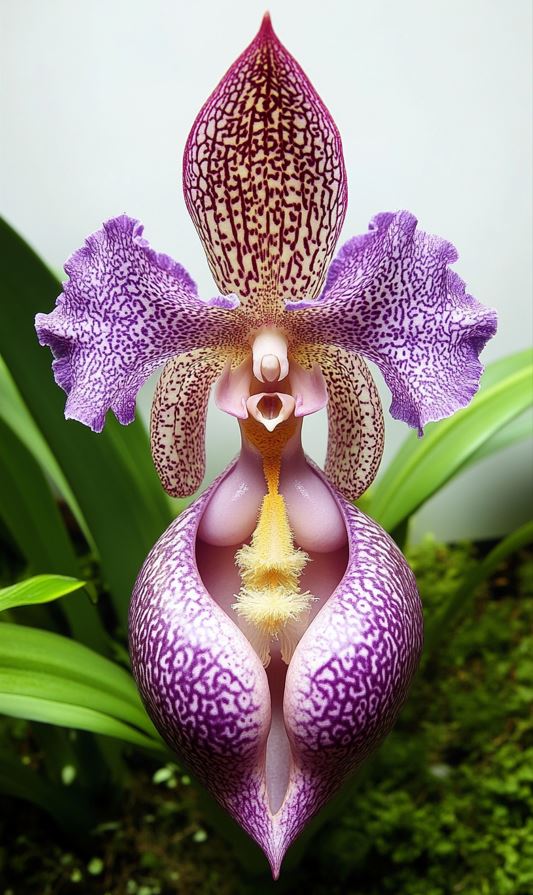
A melanistic Fox, one of the rarest animals on the planet.
Over the course of two months, photographer Sam Gaby gained the trust of a unique-looking fox in Newfoundland.
The pair have built a relationship that allowed the photographer to capture the wild creature’s stunning photographs in its natural habitat.
Cross foxes are a fairly common sight to those who live in northern North America, where they are more abundant.
The beautiful creatures have an orange coat mixed with dark stripes that run down their back and across their shoulders.
They make up about 30% of the Canadian red fox population, and they are still a special sight to behold.
“Our first encounter was calculated, I was focused on how not to disturb this wild animal, but at the same time, I was trying to assure him that I was not a threat”
“He was unsure about my presence, each cautious step forward was followed by two steps back, and our first encounter didn’t last long, I moved slowly, but by the time I prepared my camera and locked eyes with him, he ran off.”




Gaby worked hard to gain the animal’s trust as much as she could.
Luckily, Gaby didn’t give up and after repeated visits at sunset, the fox began to relax around the photographer and his camera.
After the first two months, Gaby returned several times during the year to check on his little friend.
During each visit, he learned a bit more about the fox and its sibling – who can often be seen in Gaby’s photographs as well.
“I am impressed with his beauty but also his level of intelligence.”
“I’ve witnessed him hunting, hiding and retrieving food stores, and interacting with other foxes. He was extremely playful, especially with his sibling, I gave them both names; Mat and Pat.”